In playrooms where creativity meets chaos, thoughtful storage solutions can transform a cluttered space into a haven of imaginative play. Drawing on years of experience in home organization and child-friendly design, I’ve gathered insights into strategies that balance neatness with accessibility. Whether you’re dealing with mountains of stuffed animals or stacks of building blocks, these playroom storage ideas will inspire functional layouts and durable storage options. From vertical shelving to hidden compartments, each concept aims to foster independence in children while keeping toys within reach. Embrace your inner designer as we explore innovative ways to shape a playroom that looks great and feels welcoming. Let’s dive in and discover storage solutions that truly delight.
1. Wall-Mounted Shelves for Playroom Storage
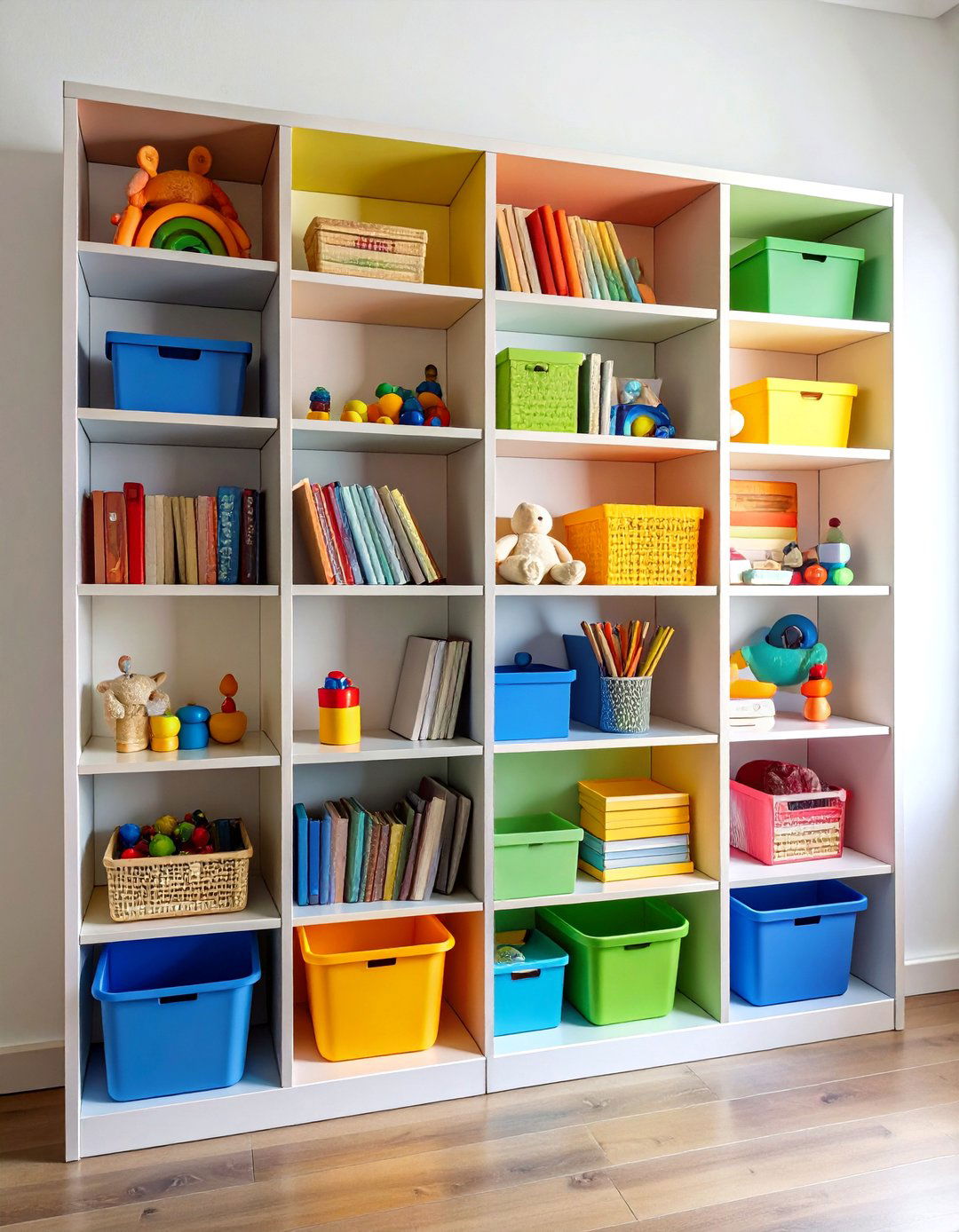
Wall-mounted shelves offer a versatile storage solution that keeps playroom floors clear and toys organized. By installing floating shelves at varying heights, you can create dedicated zones for books, stuffed animals, and decorative bins. The clean lines of wall-mounted shelves blend seamlessly with any décor style, whether modern minimalist or colorful kid-friendly themes. Children can learn to reach for and return items independently, fostering responsibility and order. These shelves are particularly effective in smaller playrooms where maximizing vertical space is essential. Combine open shelves with closed cubbies to conceal less-followed toys and display favorite pieces prominently. Embrace wall-mounted storage for a streamlined, clutter-free playroom.
2. Labelled Toy Bins for Playroom Storage
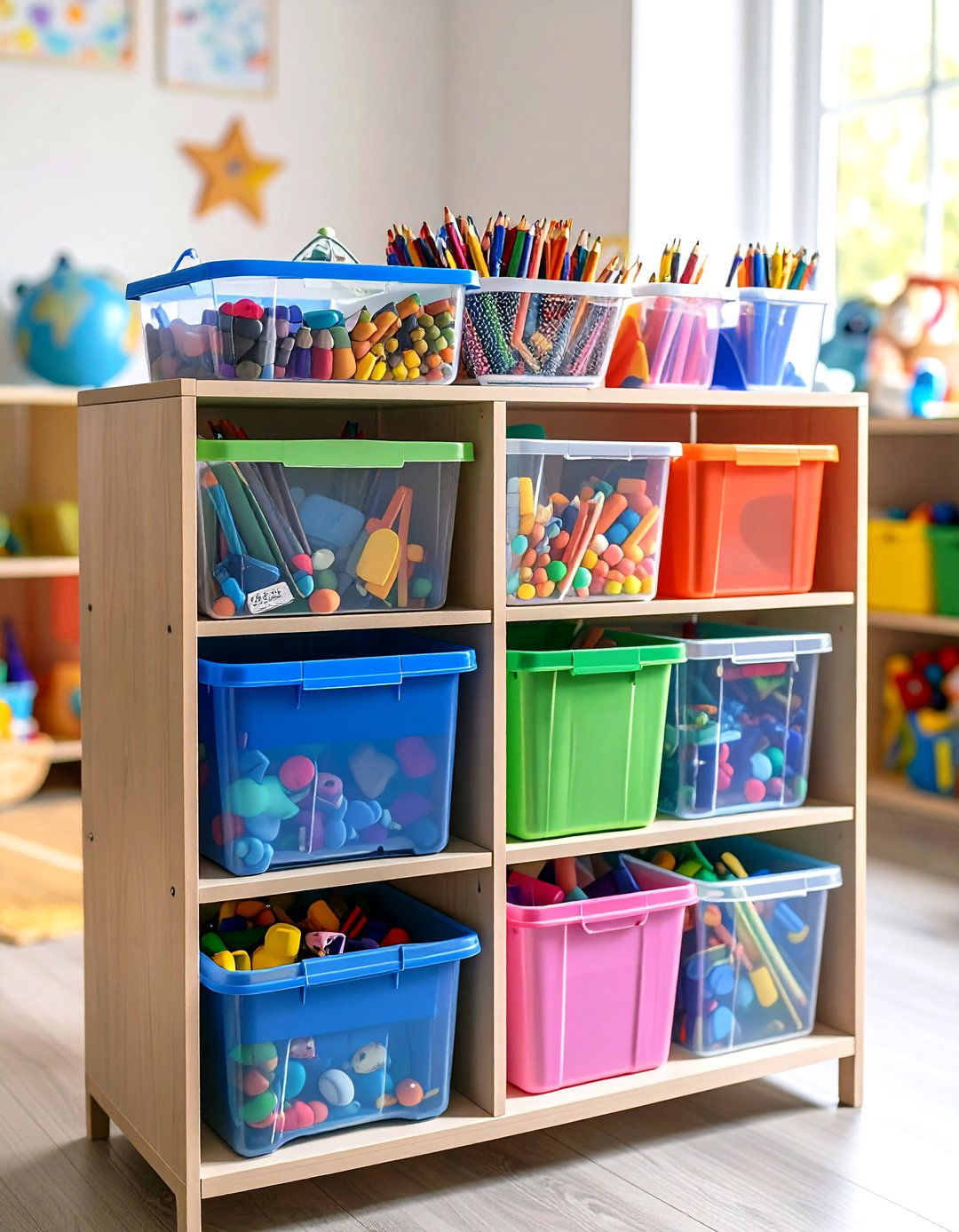
Labeled toy bins make sorting and retrieving items in a playroom effortless for both kids and adults. By assigning each bin a simple label—whether through pictures, words, or color-coding—you can reinforce organizational habits while reducing cleanup time. Transparent bins reveal contents at a glance, while opaque options allow you to conceal clutter for a tidier look. Ideal for categorizing blocks, dolls, art supplies, and puzzles, these bins slide into shelves or fit neatly under benches. Engaging children in the labeling process boosts independence and ownership over their space. Opt for durable, stackable containers that grow with your child to maintain order in a dynamic playroom environment.
3. Under-Bench Drawers in Playroom Storage
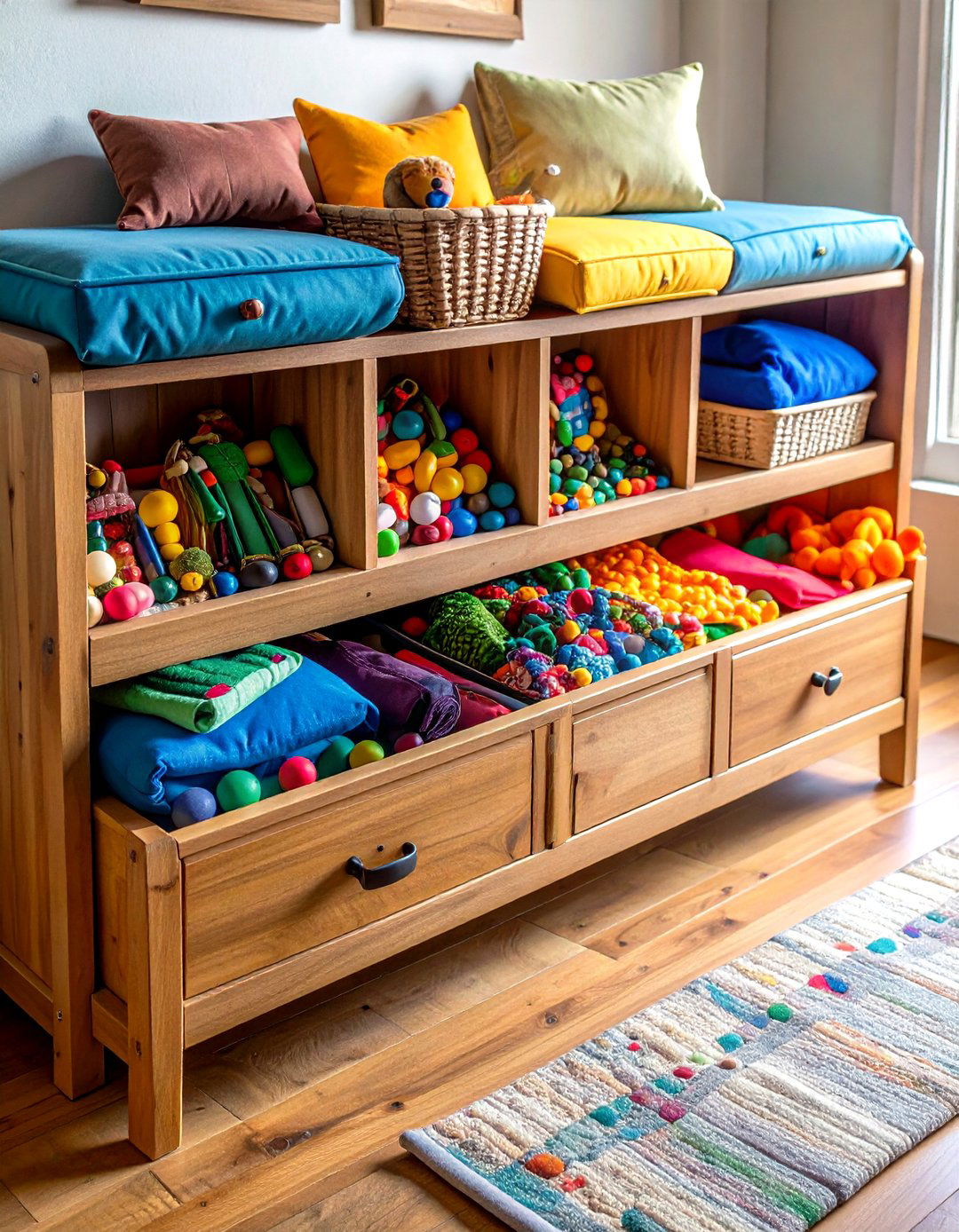
Built-in drawers under benches transform seating in a playroom into critical storage real estate. These concealed drawers slide smoothly beneath cushioned seats or window ledges, offering a discreet home for board games, dress-up costumes, and seasonal toys. Blending functionality with aesthetics, under-bench storage maintains a sleek design while hiding clutter from view. Drawers can be customized with dividers to separate small pieces like building blocks or art supplies. Easy-to-grip handles at child height encourage young ones to stow away items independently. Whether placed along a sunny window or as part of a cozy reading nook, under-bench storage maximizes every inch of playroom space without sacrificing style or accessibility.
4. Cube Shelving with Fabric Baskets for Playroom Storage
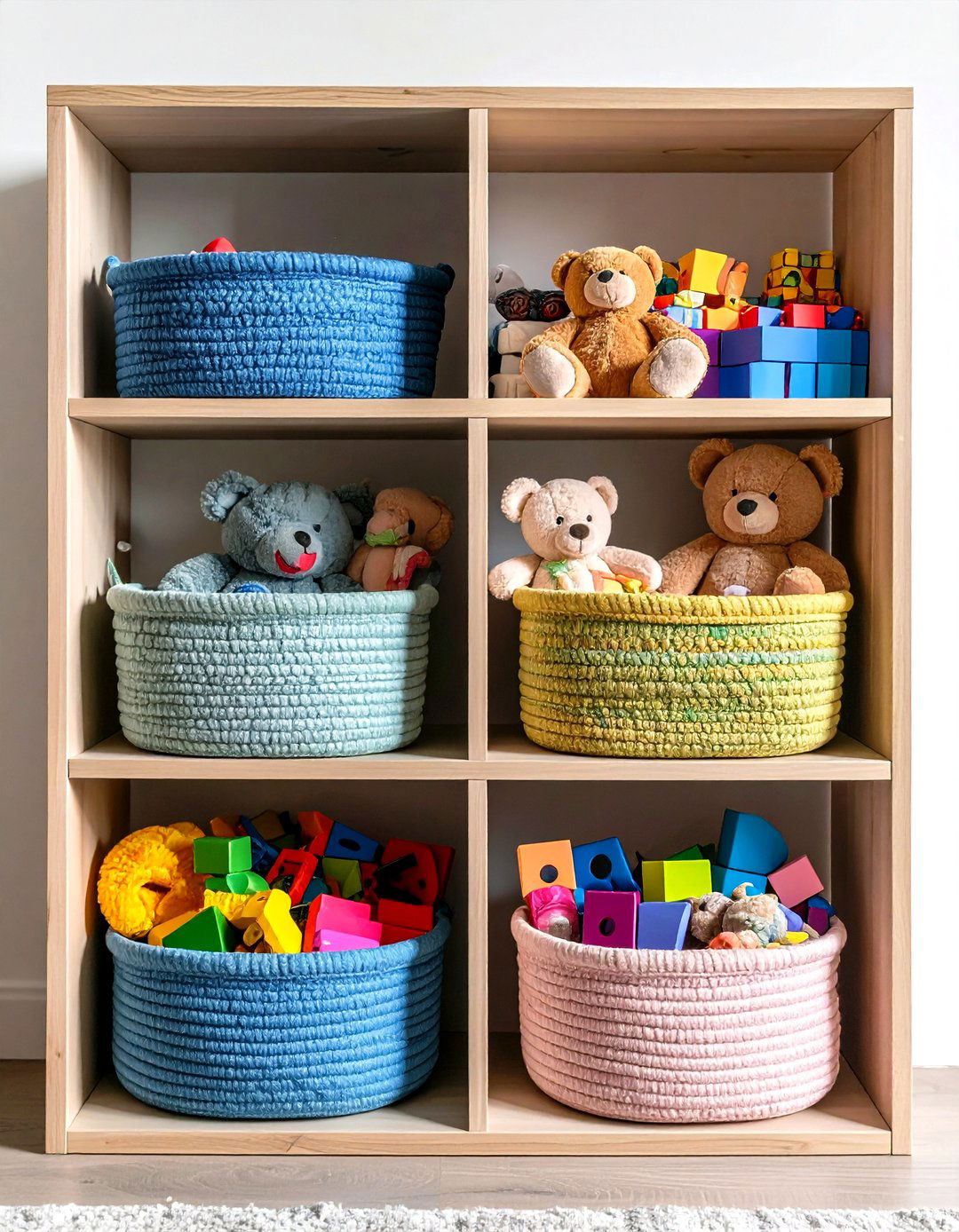
Cube shelving units paired with fabric baskets offer flexible storage for busy playrooms. The open cubes accommodate baskets in various sizes, providing an orderly home for plush toys, art materials, and construction sets. Fabric baskets soften the room’s look while making items easy to grab and replace. Choosing baskets in coordinating colors or patterns can reinforce a playful aesthetic. Clear labeling on basket fronts helps kids locate what they need without rummaging through piles. Cube shelving often comes in modular configurations, allowing you to add or remove compartments as your child’s interests change. By mixing open cubes with baskets, you balance visible displays with hidden storage to keep a playroom organized and inviting.
5. Corner Carousels to Maximize Playroom Storage

Rotating corner carousels make underutilized corners in a playroom functional and accessible. These spinning racks feature multiple tiers, ideal for corralling small toys, art supplies, and sensory materials. The 360-degree rotation allows children to browse and select items without causing a traffic jam in central areas. Corner carousels can be anchored securely to walls for safety, while the rotating mechanism stays sturdy under frequent use. By fitting snugly into corner spaces, they free up primary wall areas for larger shelving or décor. Opt for adjustable shelves or removable bins on each tier to adapt the carousel to changing storage needs. Implement this clever solution to keep a busy playroom organized and clutter-free.
6. Pegboard Walls for Playroom Storage
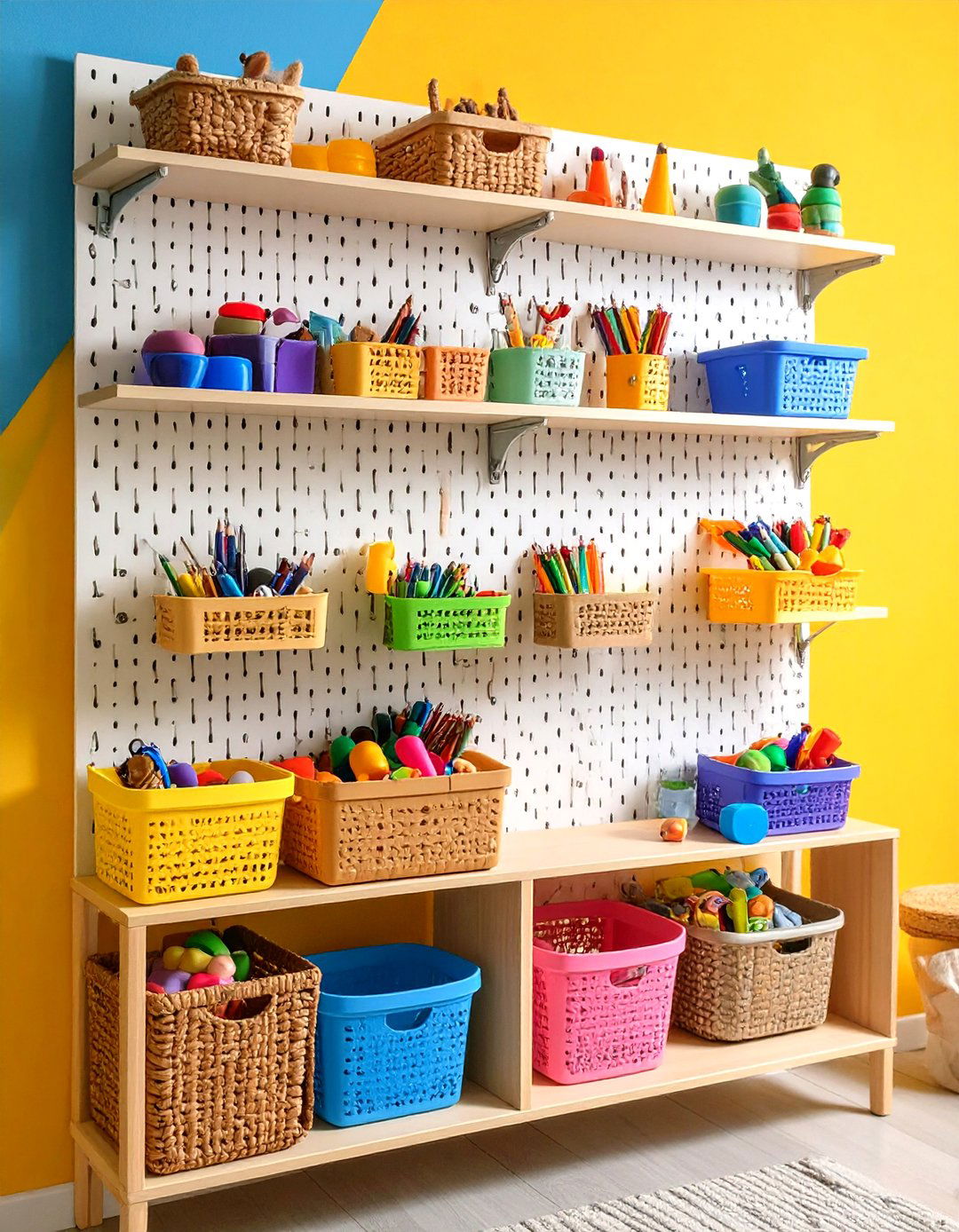
Pegboard walls offer customizable storage for a playroom that evolves with your child. By attaching hooks, baskets, and shelves to a blank pegboard panel, you can display frequently used art supplies, small toys, and sensory bins at adjustable heights. This tactile storage solution encourages kids to participate in organizing by rearranging hooks and hanging tools themselves. Pegboards can be painted in vibrant colors or left neutral to blend with existing décor. Mounting pegboards along a craft zone keeps scissors, ribbons, and paper neatly accessible. Adding shelves to pegboards expands storage capacity while maintaining a streamlined wall surface. Embrace pegboard walls for an interactive storage system that adapts to playroom activities.
7. Rolling Craft Carts for Playroom Organization

Rolling craft carts are a portable storage solution perfect for art stations in any playroom. Featuring multiple tiers of trays and compartments, these carts accommodate markers, paints, paper, and crafting tools. Wheels lock in place, securing the cart during creative sessions and allowing easy relocation to different corners or rooms. The open design keeps supplies visible and accessible for young artists. To personalize, add adhesive labels or color-coded bins on each level. Craft carts with adjustable heights and removable bins adapt as children grow and project sizes change. Introduce a rolling cart to bring structure and mobility to messy playroom activities, making cleanup a breeze for parents and kids alike.
8. Hanging Shoe Organizers for Playroom Storage
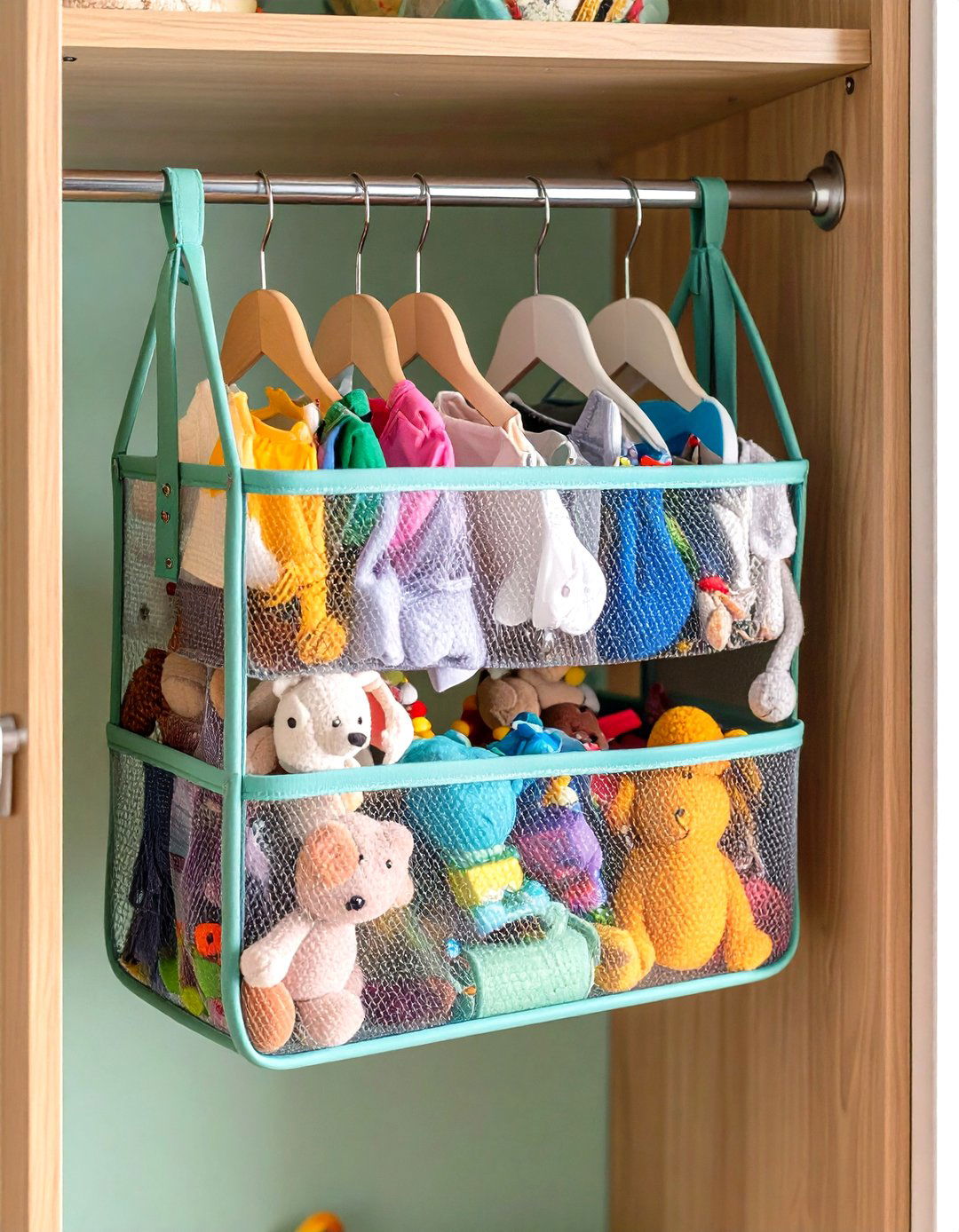
Clear or mesh hanging shoe organizers provide an ingenious solution for storing small toys and accessories in a playroom. Suspended from closet rods or wall hooks, these pockets accommodate items like action figures, hair accessories, and art supplies without taking up shelf space. The transparency of each pocket allows children to locate items quickly, reducing frustration during cleanup. Organizers with reinforced grommets ensure durability under daily use, while removable pockets make washing simple. Shoe organizers can also be hung on playroom doors to maximize vertical storage. Encourage children to place items in corresponding pockets by using picture labels, promoting tidiness and independence in maintaining playroom order.
9. Over-the-Door Pockets in Playroom Storage

Over-the-door pocket organizers save floor and shelf space in a playroom by utilizing the back of doors. Available in clear or fabric varieties, these pockets can store puzzles, coloring books, and small toys. By grouping similar items in designated pockets, children can find what they want without creating piles on the floor. Installing an over-the-door organizer takes minutes, and adjustable hooks accommodate different door thicknesses. Removable pockets can be detached for washing or repurposed in closets. Pairing this system with labels or images helps non-readers participate. This easy, economical storage hack keeps a playroom tidy and maximizes underutilized surfaces for efficient toy management.
10. Built-In Cubbies for Playroom Storage
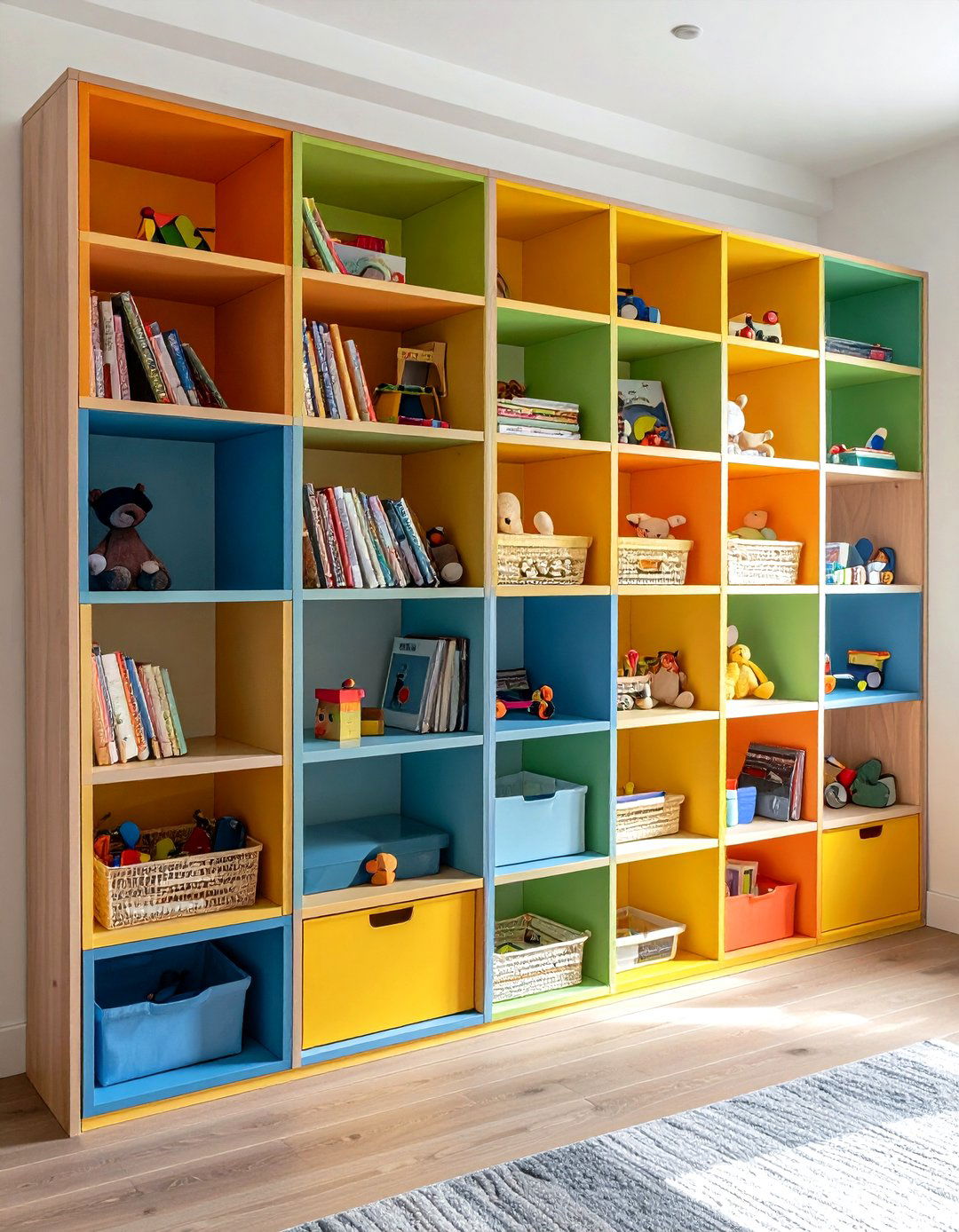
Custom-built cubby units bring a polished look to a playroom while delivering ample storage for toys and books. Constructed from sturdy materials like wood or MDF, built-in cubbies can be integrated beneath windows or along entire walls. Adjustable shelves or pull-out bins slot into each cubby, allowing for flexibility as kids’ collections evolve. Cubbies sized for specific items—such as board games, puzzles, or craft bins—keep everything in its place. Painting the cubby interiors in bright hues adds a playful touch. Encourage organization by having children assign a home for each toy, teaching them responsibility. Built-in cubbies blend function with design, elevating any playroom’s style and tidiness.
11. Low Open-Front Bins for Playroom Storage
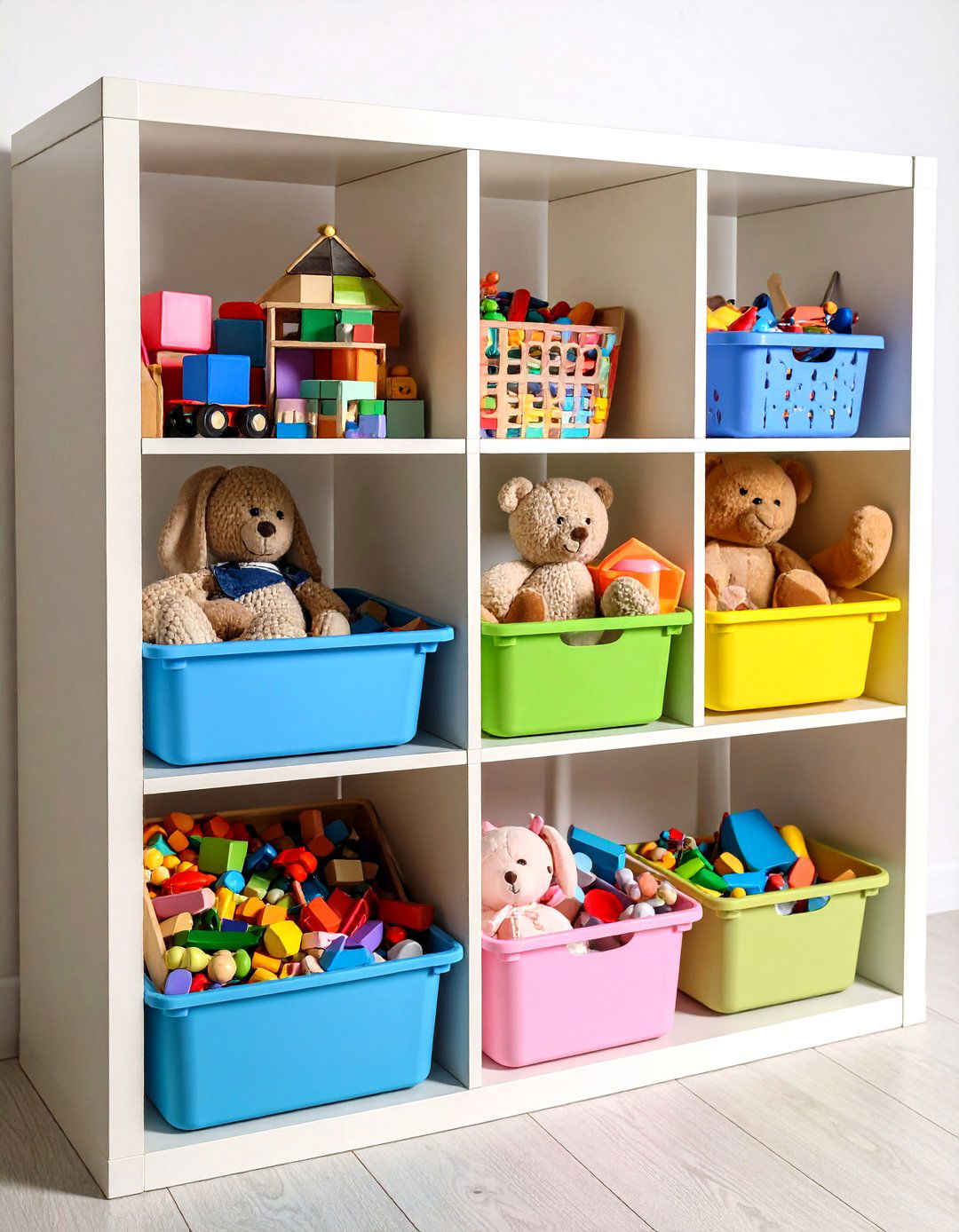
Low open-front bins on short shelves empower toddlers to access and return toys independently, fostering self-sufficiency in the playroom. These shallow bins slide easily in and out, making cleanup a quick and intuitive process. By organizing play items into categories like vehicles, dolls, and blocks, children can learn sorting skills through hands-on interaction. Open-front bins also allow caregivers to maintain order without constant supervision, since contents remain visible at a glance. Choose bins with sturdy handles and smooth edges for safety. Grouping bins on a modular shelving unit adapts as your child grows and preferences shift. Implement open-front storage to cultivate an organized and child-friendly playroom.
12. Storage Ottomans in Playroom Storage
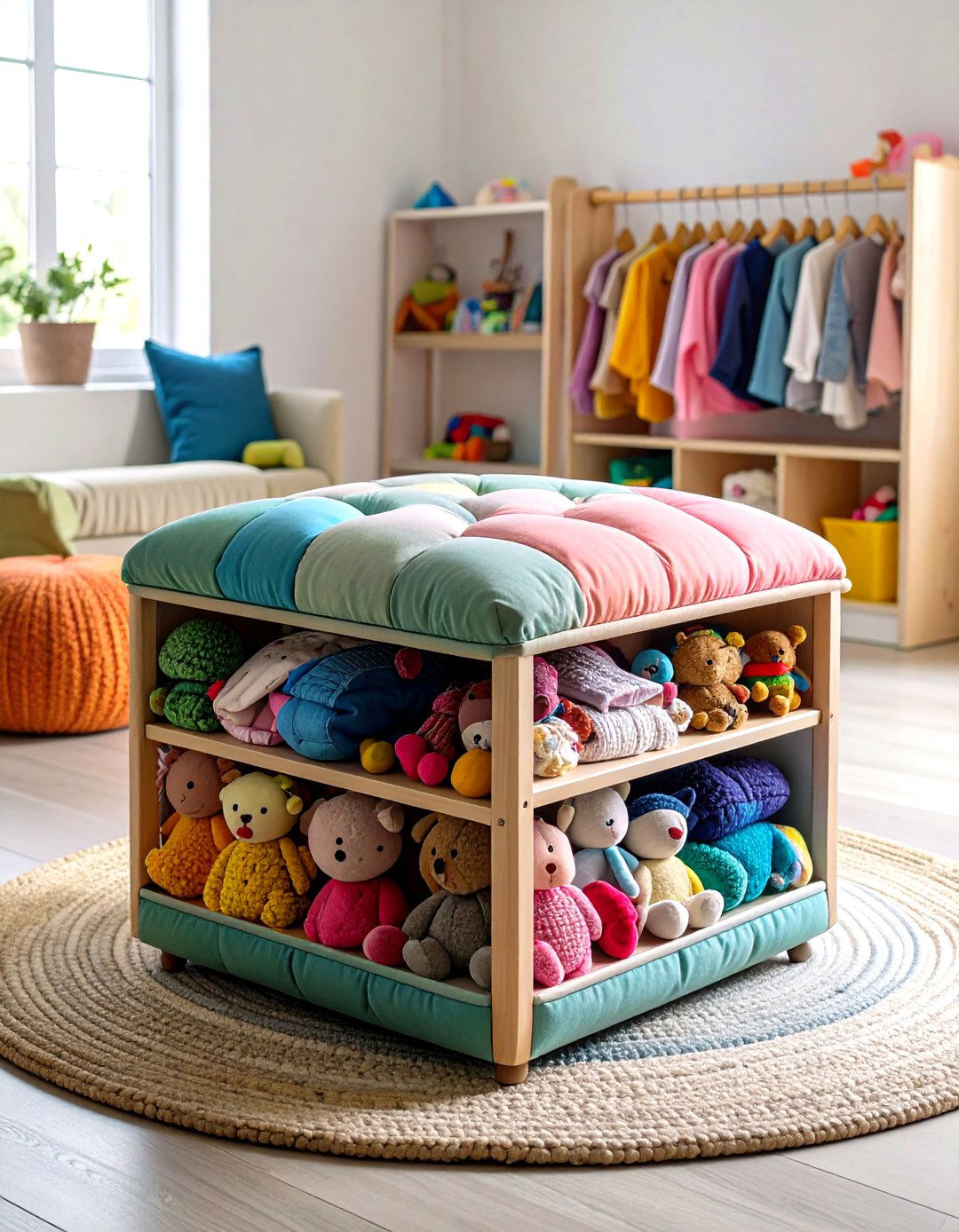
Dual-purpose storage ottomans offer comfortable seating and hidden compartments in a playroom. These cushioned stools lift to reveal ample space for blankets, oversized plush toys, or dress-up clothes. The soft top doubles as a cozy spot for reading or game time, while sturdy hinges ensure kid-safe operation. Choose ottomans upholstered in durable, stain-resistant fabrics to withstand spills and daily use. Placing one or two around an activity rug creates a modular seating area that can be rearranged on the fly. Storage ottomans conceal clutter instantly, maintaining a tidy appearance when play sessions end. Incorporate these versatile pieces to combine relaxation and organization in any playroom setting.
13. Chalkboard Magnetic Walls in Playroom Storage
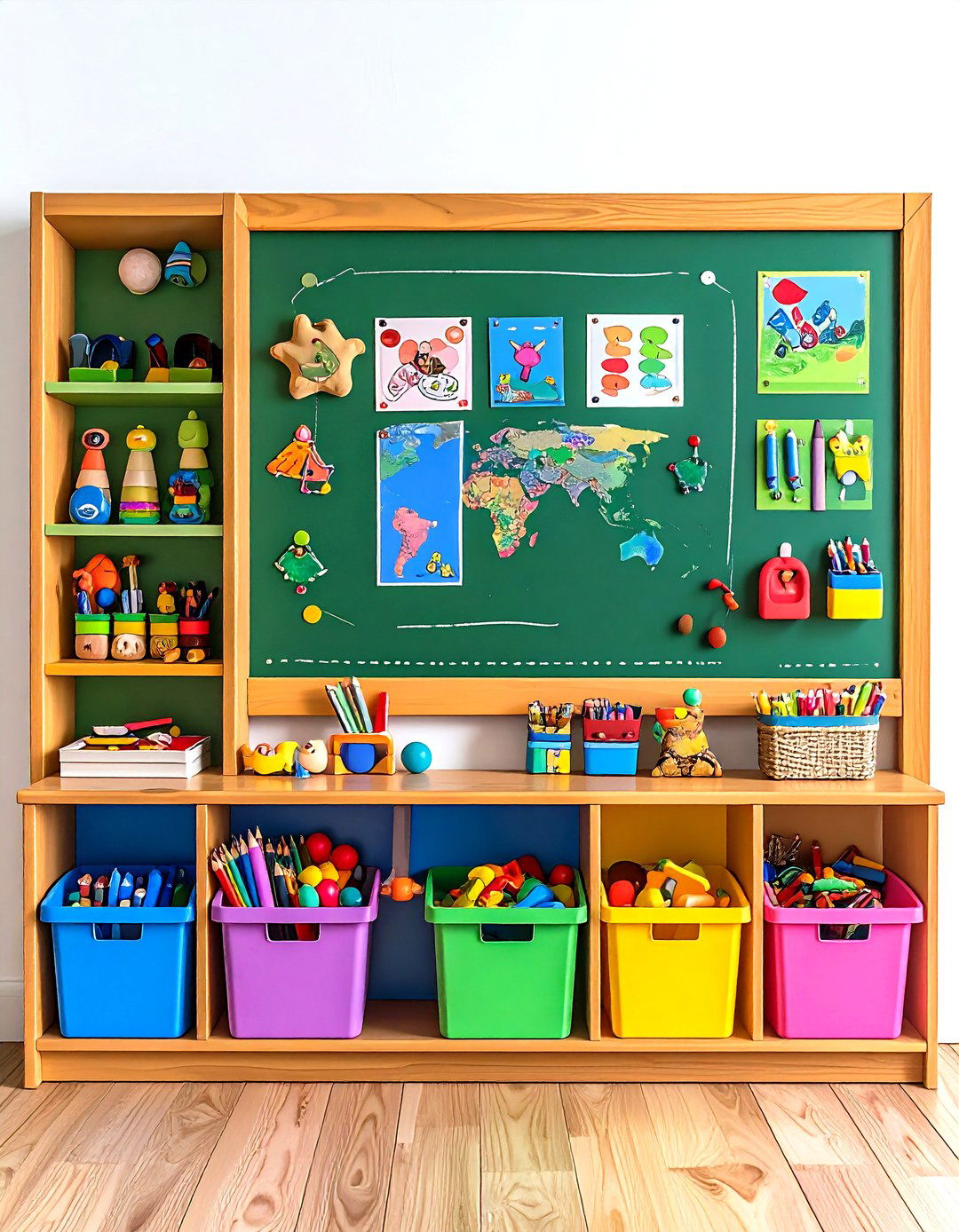
Incorporating a chalkboard-backed magnetic wall adds creativity and functionality to a playroom. Painted with magnetic chalkboard paint, this surface serves as an art canvas and a storage hub for magnetic bins and buckets. Children can draw, write, and attach lightweight metal containers holding chalk, erasers, or small toys. The dual functionality encourages artistic exploration and easy cleanup. Mount the wall at child height to foster independence and to keep supplies organized off counters or tables. The dark chalkboard background also complements colorful playroom accessories. Refresh the wall with a new coat of paint when it shows wear, ensuring a long-lasting, interactive storage solution that doubles as a creative station.
14. Crate Stack Systems for Playroom Storage
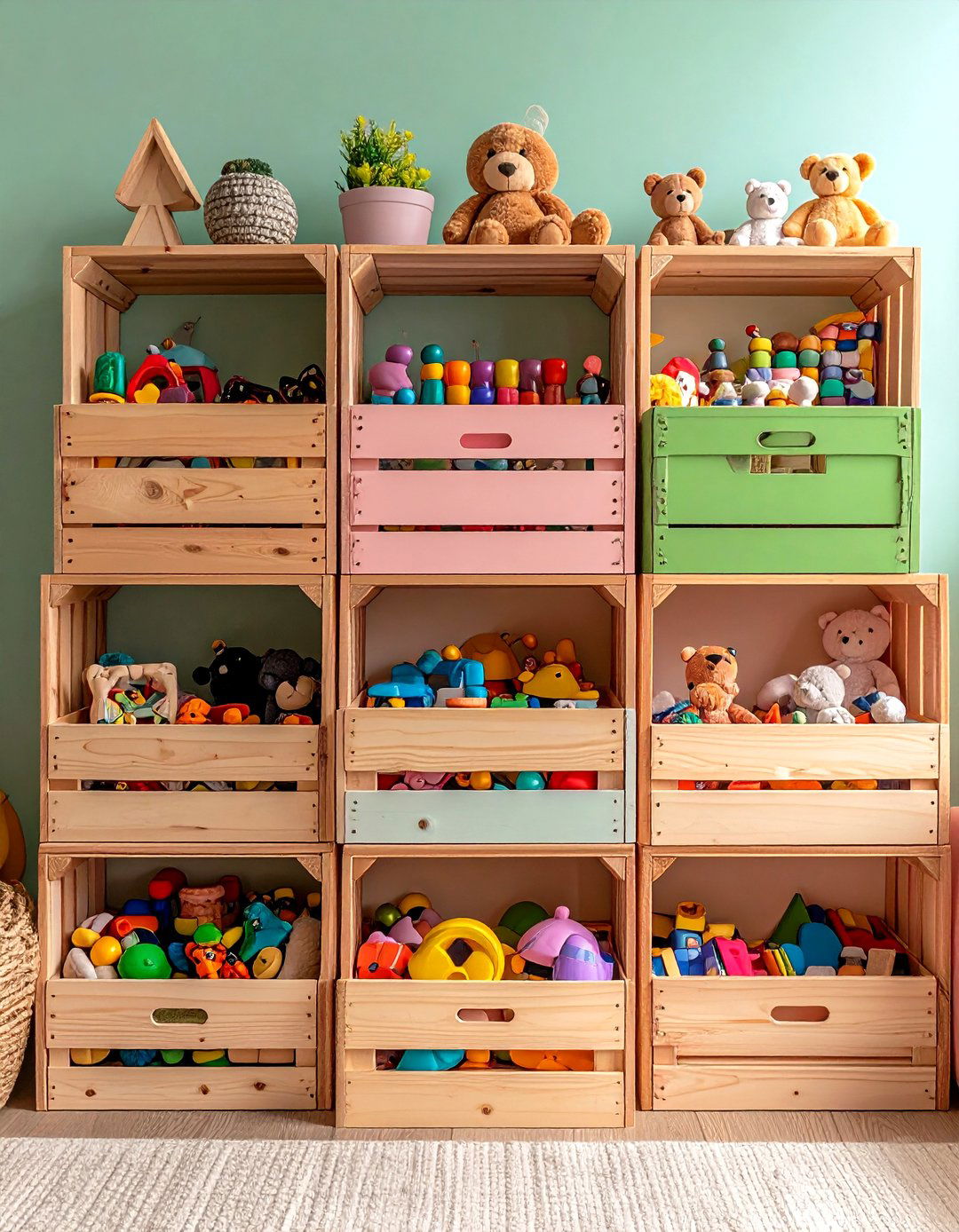
Stackable wooden or plastic crates create a modular storage system in a playroom, perfect for growing collections. Crates can be arranged in columns or staggered formations against walls, offering a rustic yet functional look. Each crate holds books, plush toys, or block sets, and adding clear labels keeps things orderly. Drill crates together or secure them to shelving frames to prevent tipping. Paint crate exteriors in bright hues or leave them natural for a versatile aesthetic. The open structure allows children to see and retrieve items easily. By adjusting the number of crates or adding divider inserts, you can adapt this system to changing storage requirements as your playroom evolves.
15. Clear Plastic Drawers for Playroom Supplies
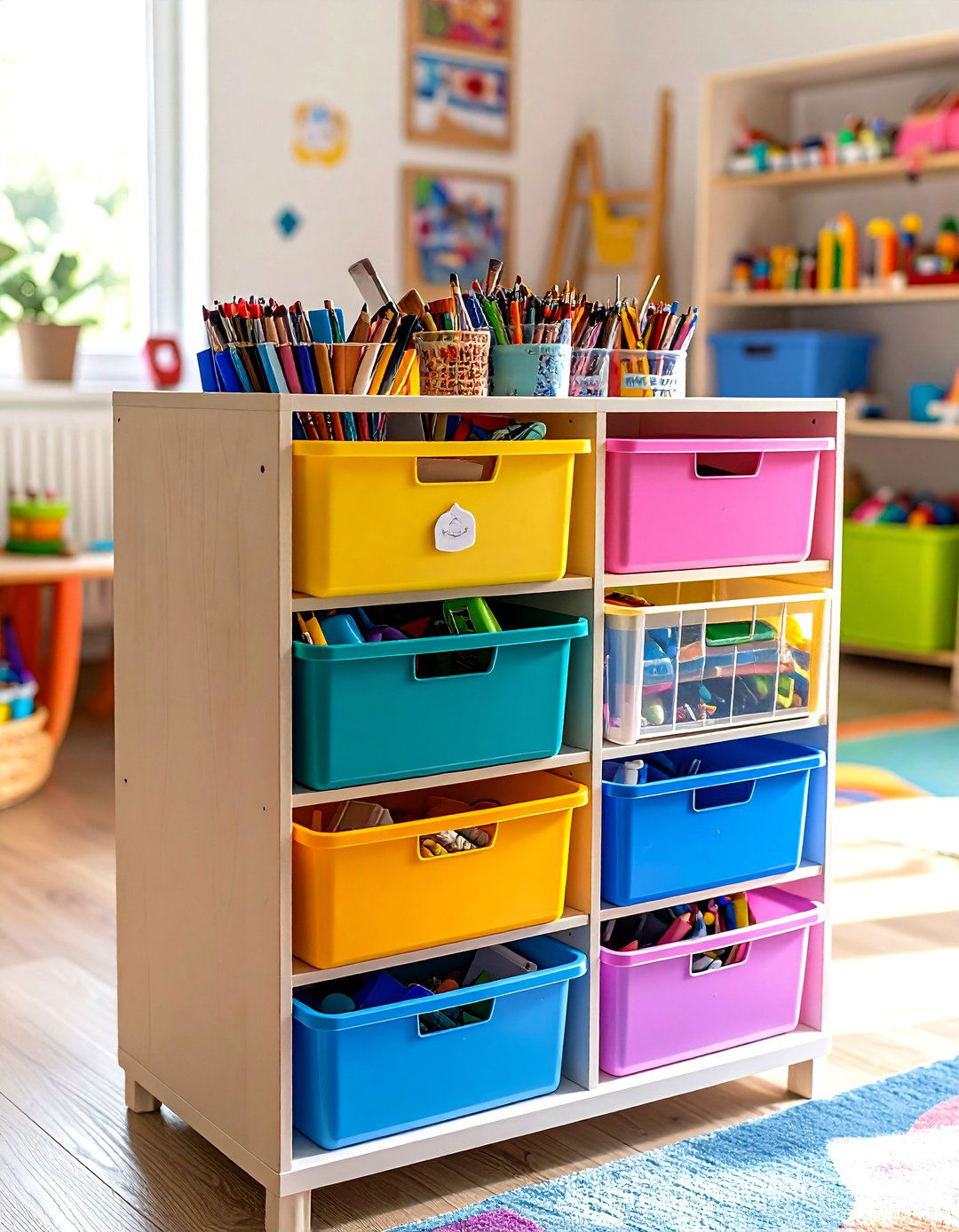
Clear plastic drawer units offer versatile storage for art supplies, small toys, and classroom-like organization in a playroom. Stackable and available in multiple drawer sizes, these units let you sort crayons, stickers, and craft materials into separate compartments. The transparent fronts display contents clearly, reducing the need for trial-and-error searches and speeding up cleanup. Units on wheels can be moved to crafting tables or tucked under desks when not in use. Label each drawer with pictures or words to help non-readers navigate the system. Durable plastic resists spills and is easy to wipe clean. Incorporate plastic drawers to bring lab-style order to a playroom’s creative corner.
16. DIY LEGO Storage Table for Playroom
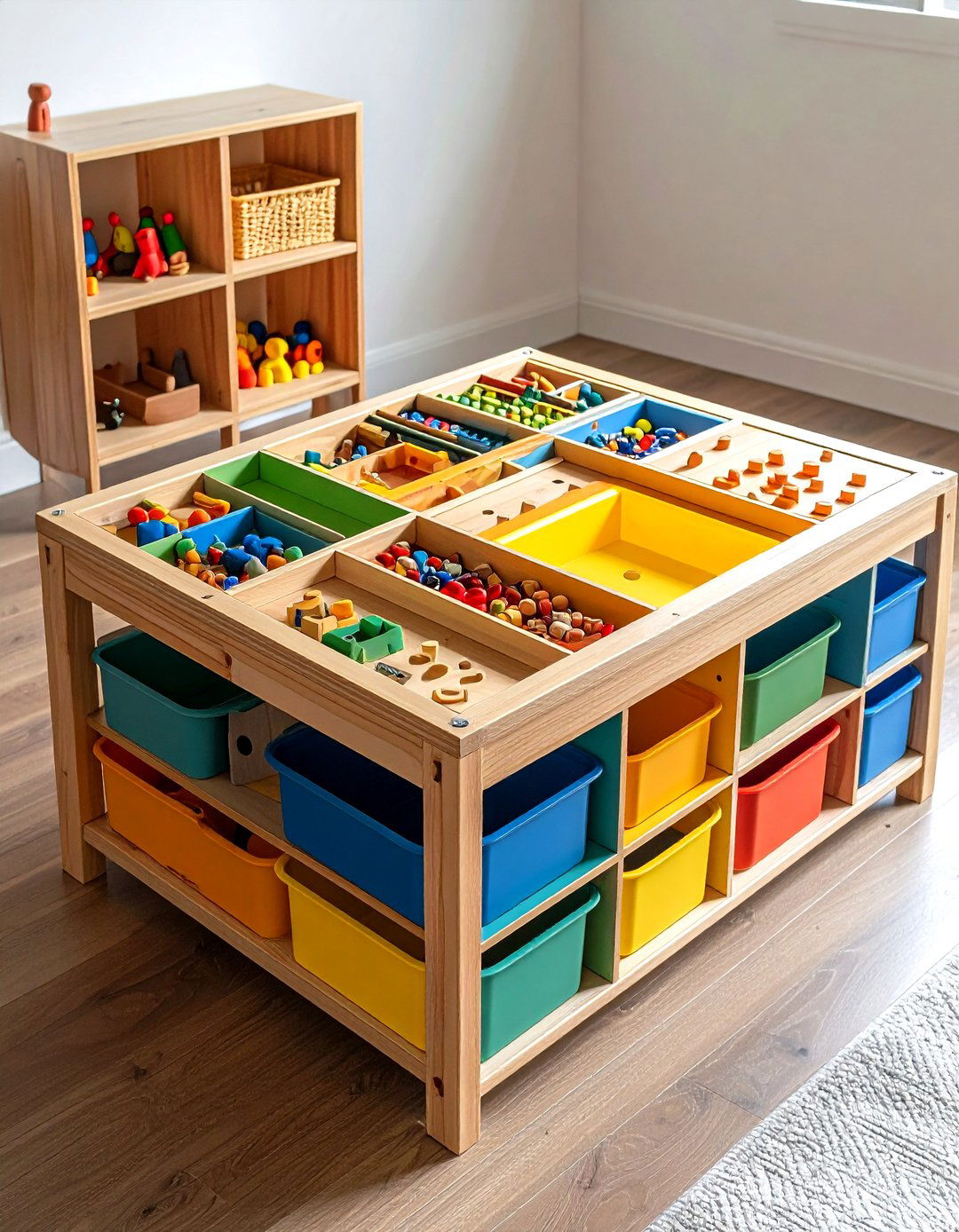
DIY LEGO storage tables combine a built-in playing surface with under-table storage bins, creating a dedicated hub for brick-building adventures in a playroom. By mounting detachable LEGO baseplates on a sturdy tabletop and lining underneath with bins or TROFAST units, children enjoy easy access to bricks without scattering them across floors. This all-in-one piece encourages sustained creativity and keeps LEGO sets neatly contained. Plans for DIY tables often use affordable materials like plywood and plastic containers, making assembly a weekend project. Personalizing the table with paint or decals can match room décor. Embrace a DIY LEGO table to centralize playful learning and maintain a clutter-free playroom space.
17. Ceiling-Hung Baskets for Playroom Storage

Ceiling-hung baskets turn vertical overhead space into practical storage for lightweight toys and craft materials in a playroom. Suspended by sturdy hooks from ceiling joists, wire or rattan baskets keep dress-up costumes, musical instruments, or plush friends off the floor. Clear plastic or mesh options allow you to see contents at a glance. This unique approach frees wall and floor space for larger furniture, rugs, and play zones. Adjust basket heights to accommodate different age ranges and ensure safe access. Removable liners or lidded baskets protect items from dust. Ceiling storage adds visual interest while introducing an unexpected element of fun to any playroom design.
18. Tiered Book Shelves for Playroom Storage
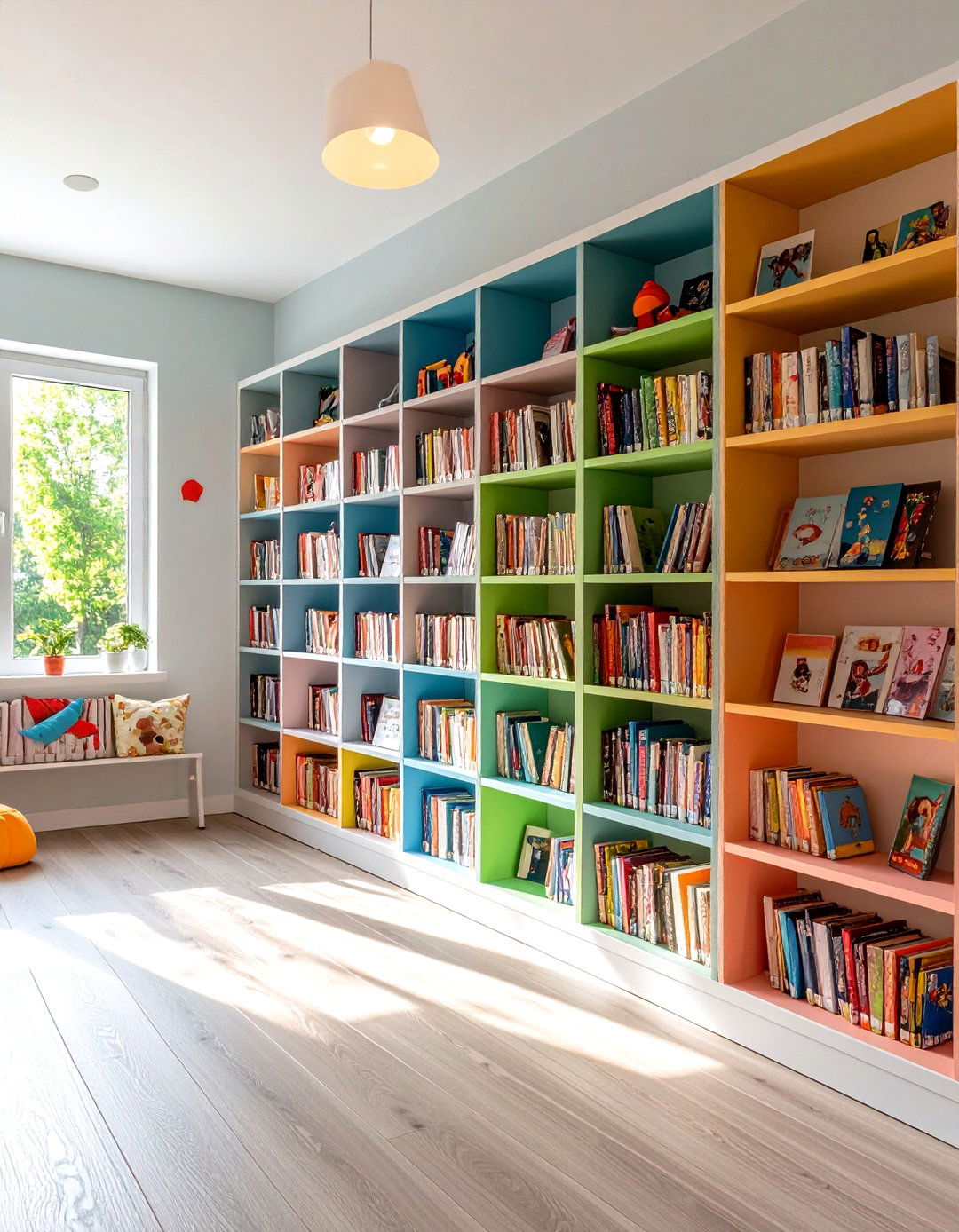
Multi-tiered book display shelves showcase children’s favorite stories while providing storage in a playroom. With slanted fronts or open cubbies, books stand upright for easy flipping, encouraging independent reading. Lower shelves ensure toddlers can reach board books, while higher tiers accommodate growing collections and picture books. Combine with labeled bins at the base for magazines or loose pages. The vertical layout uses minimal floor space and doubles as décor. Shelves constructed from durable materials like solid wood or metal withstand enthusiastic handling. Add decorative trim or painted accents to match room themes. Tiered shelving promotes literacy, keeps storytime organized, and adds a stylish focal point to any playroom.
19. Foldable Storage Baskets for Playroom Storage
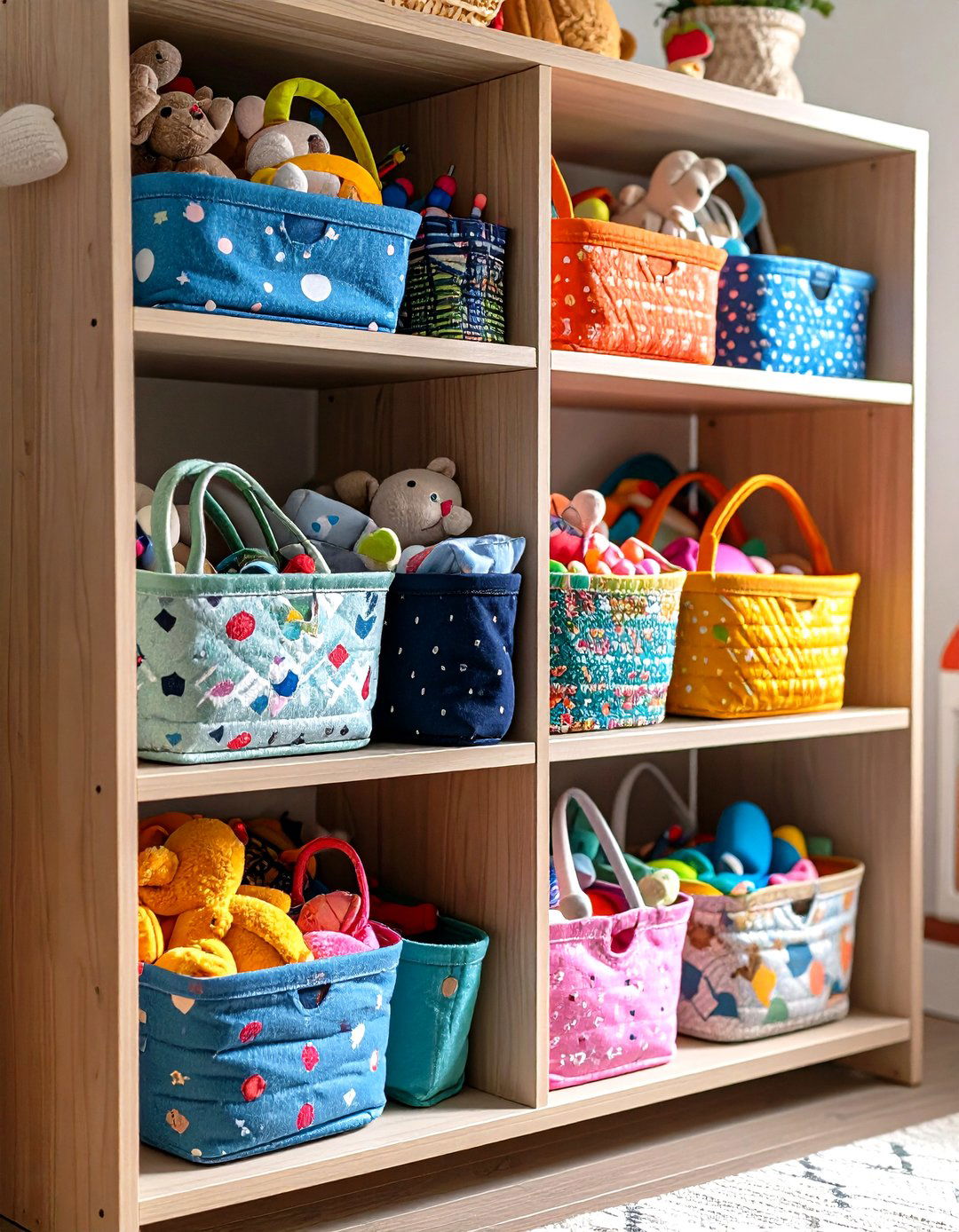
Foldable fabric baskets provide versatile, collapsible storage for a playroom that adapts to changing needs. When in use, sturdy baskets hold stuffed animals, dress-up accessories, or building blocks. After cleaning up, baskets collapse flat for convenient storage in cupboards or closets. Lightweight handles make them easy for children to carry. Choose water-resistant fabrics to protect contents from spills and easy-to-wipe surfaces. Colorful patterns and prints add personality while helping kids remember where items belong. Group baskets in open cubbies or along walls for a neat, modular look. Foldable baskets offer a quick, flexible solution to manage playroom clutter without permanent fixtures.
20. Slide-Out Trays Under Seating for Playroom Storage
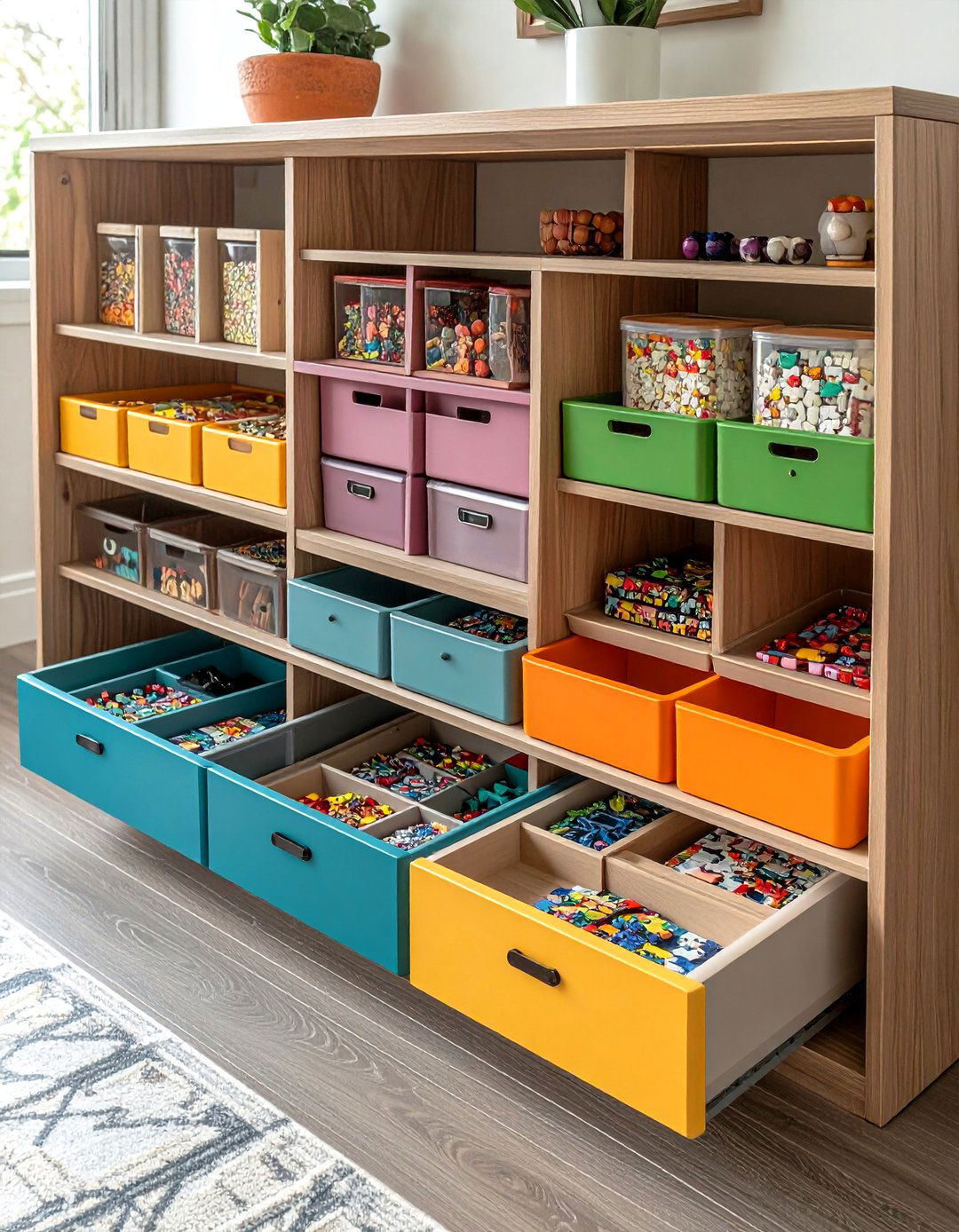
Integrating slide-out trays beneath built-in seating provides clever concealed storage in a playroom. These shallow, pull-out drawers fit under benches or window seats for stowing board games, puzzles, and art supplies. Full-extension drawer slides ensure smooth access to items at the back without removing everything in front. By tucking trays under seating, you optimize floor space while keeping storage hidden yet reachable. Add labels on drawer fronts or magnetic nameplates to maintain order. Materials like plywood or engineered wood deliver lasting durability, while painted fronts match décor themes. Slide-out storage transforms seating into an organizational powerhouse, enhancing both the function and style of any playroom nook.
Conclusion:
Creating a well-organized playroom hinges on selecting storage solutions that suit the room’s layout, children’s abilities, and the types of toys in rotation. From vertical pegboard walls to under-seat slide-out trays, these ideas prioritize accessibility, encourage independence, and maximize every inch of space. Modular systems like cube shelving with baskets and stackable crates adapt as your child’s interests evolve. Versatile furniture—such as storage ottomans and DIY LEGO tables—combines play surfaces with hidden compartments to streamline cleanup. Engaging kids in labeling and sorting fosters ownership and respect for their environment. By integrating these thoughtful storage ideas, you can transform any playroom into an organized, inspiring haven that grows alongside your family.


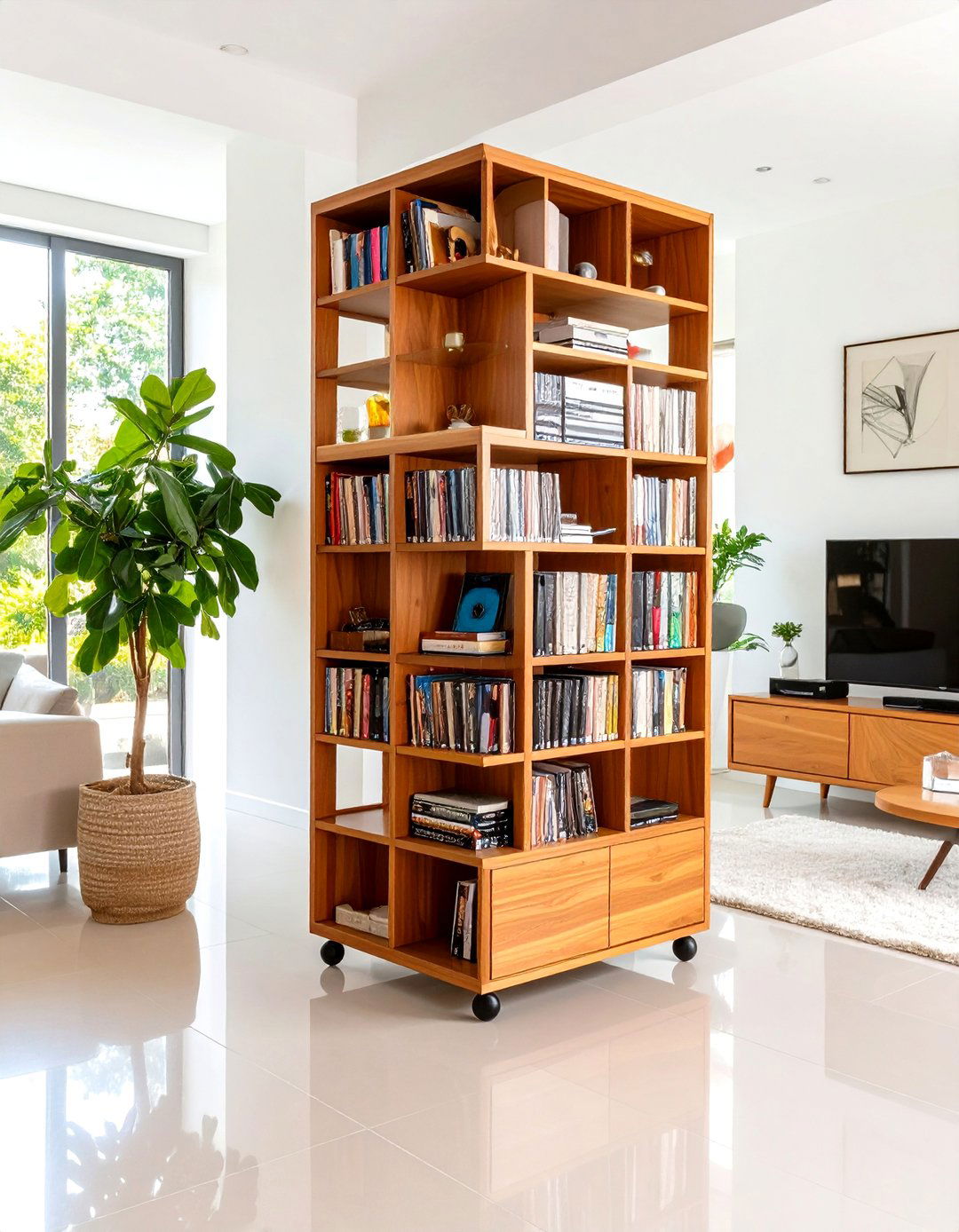
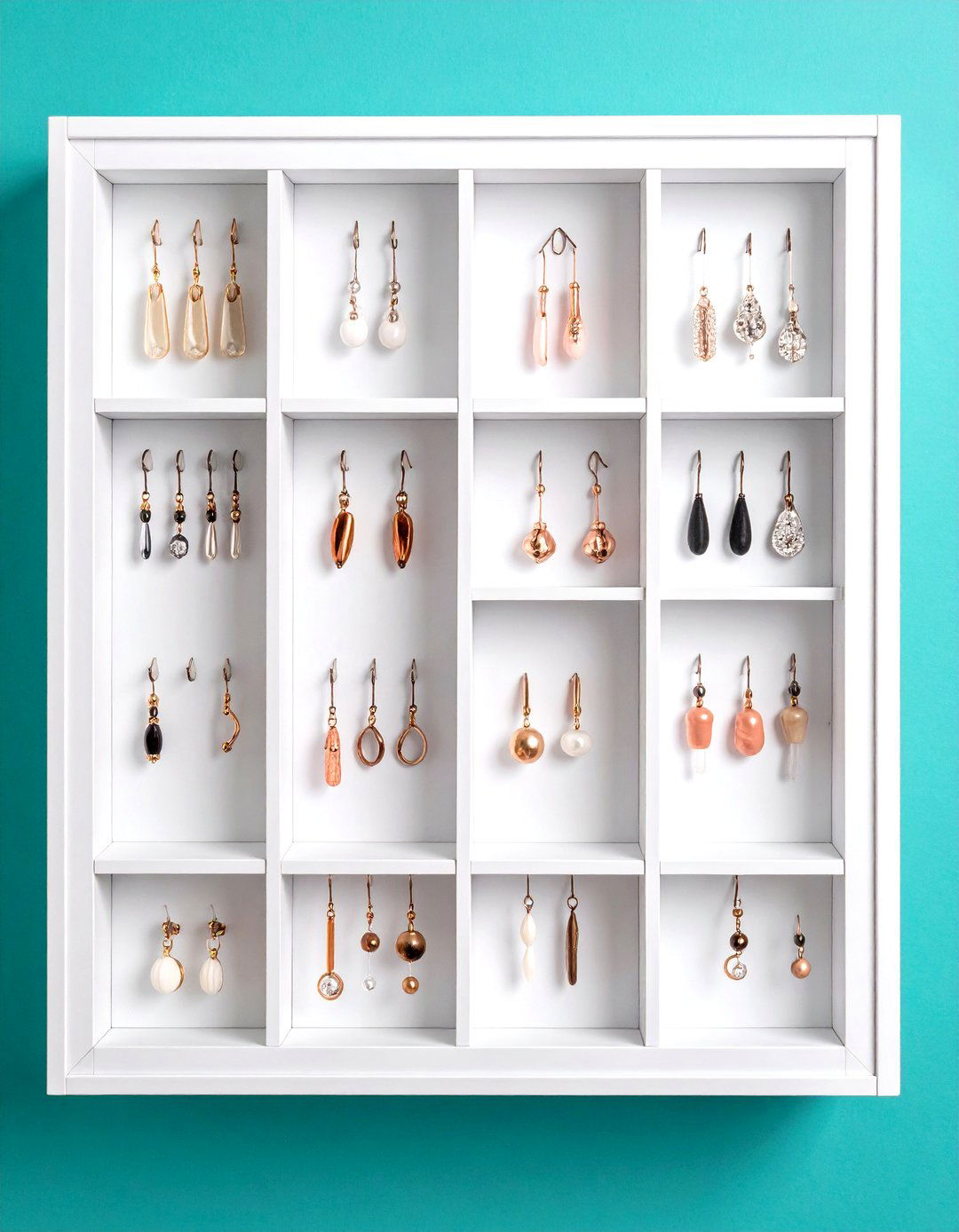
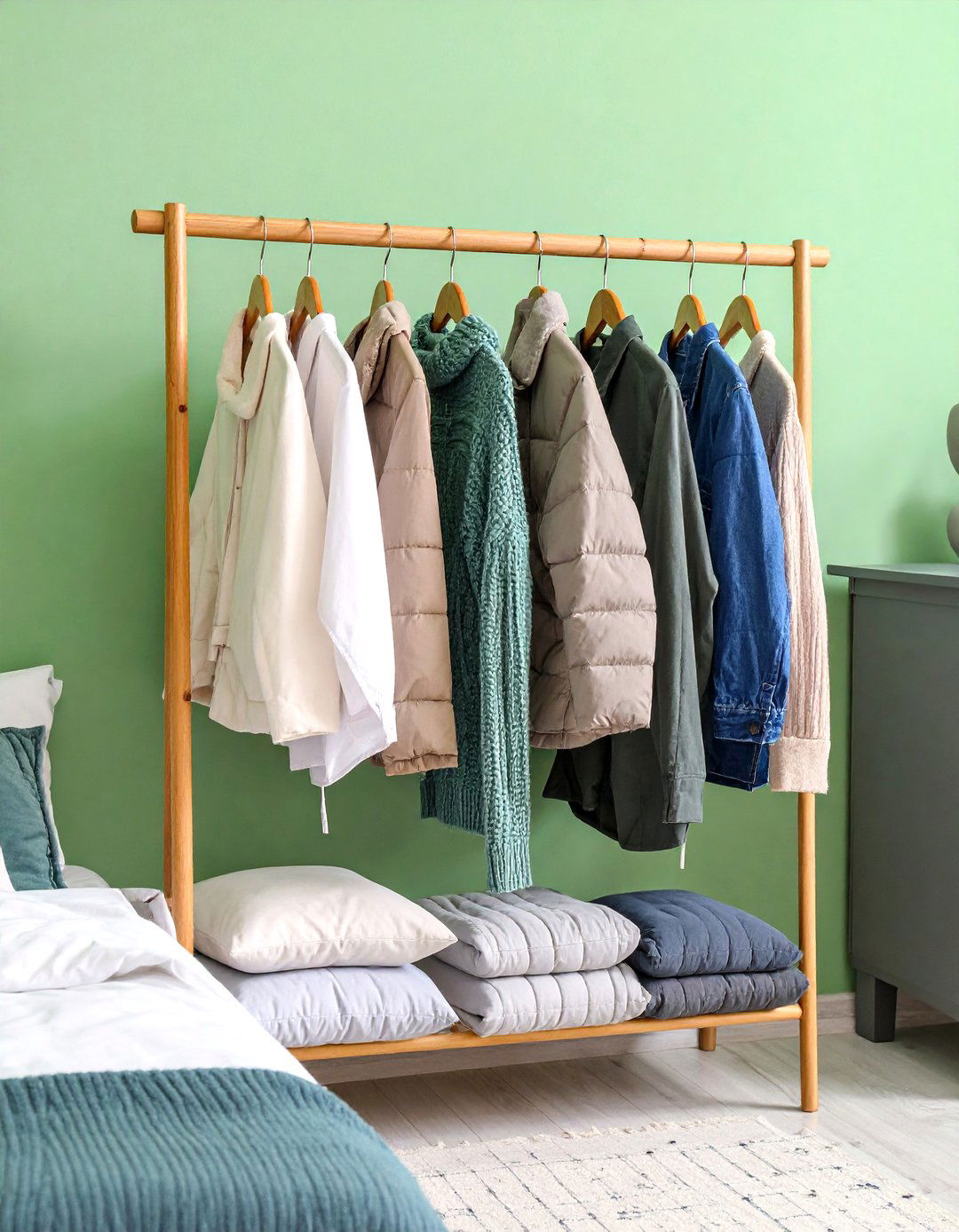
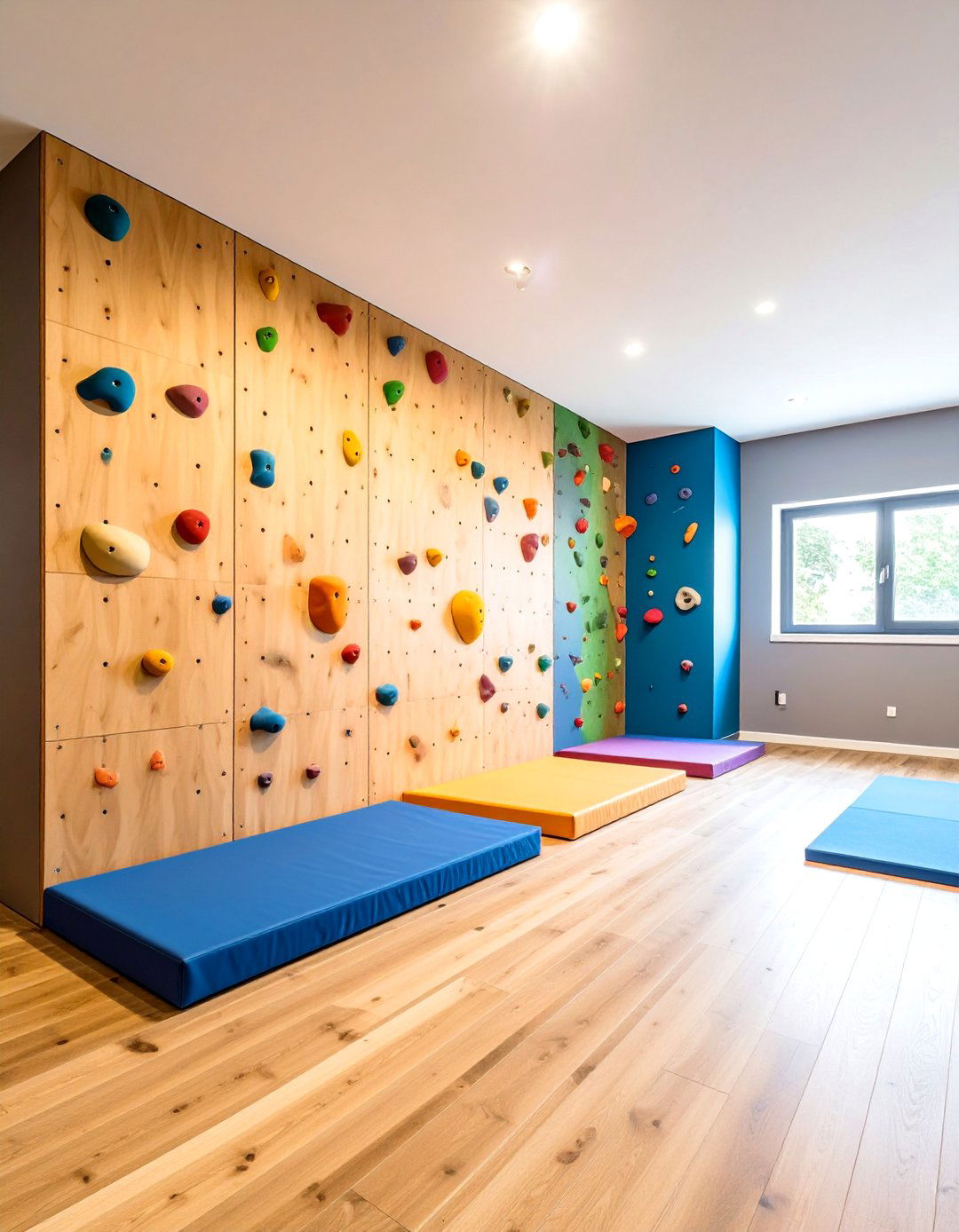
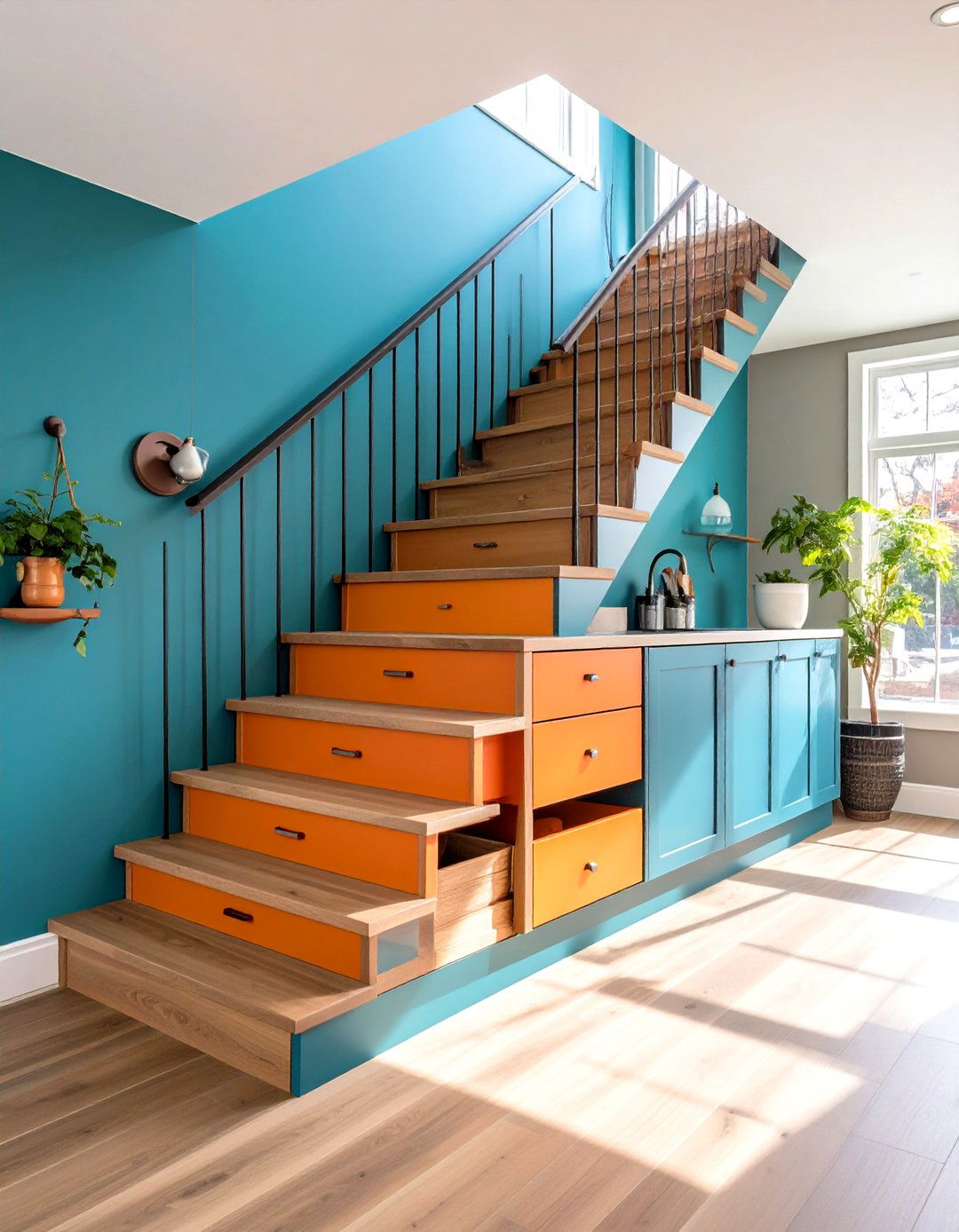
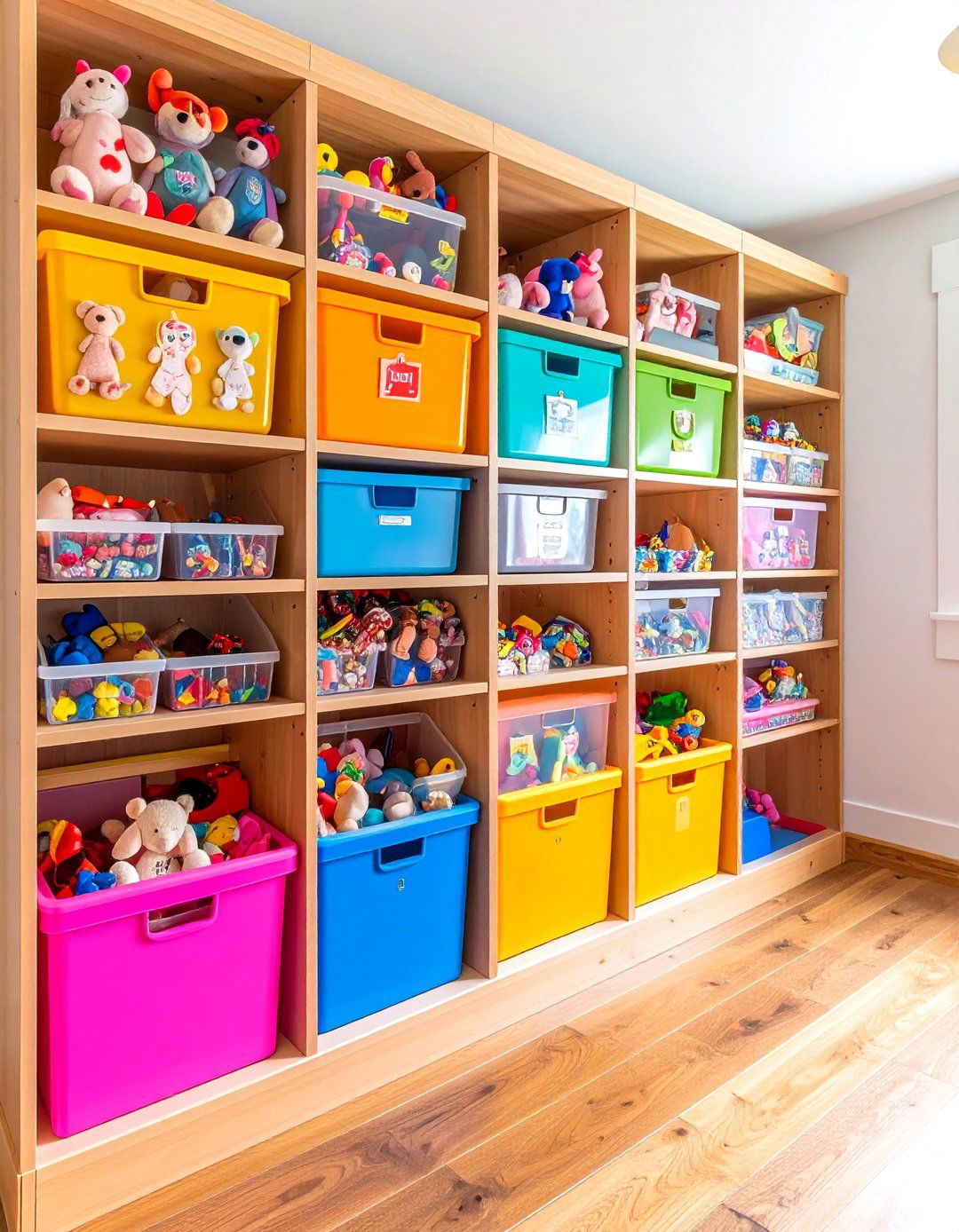
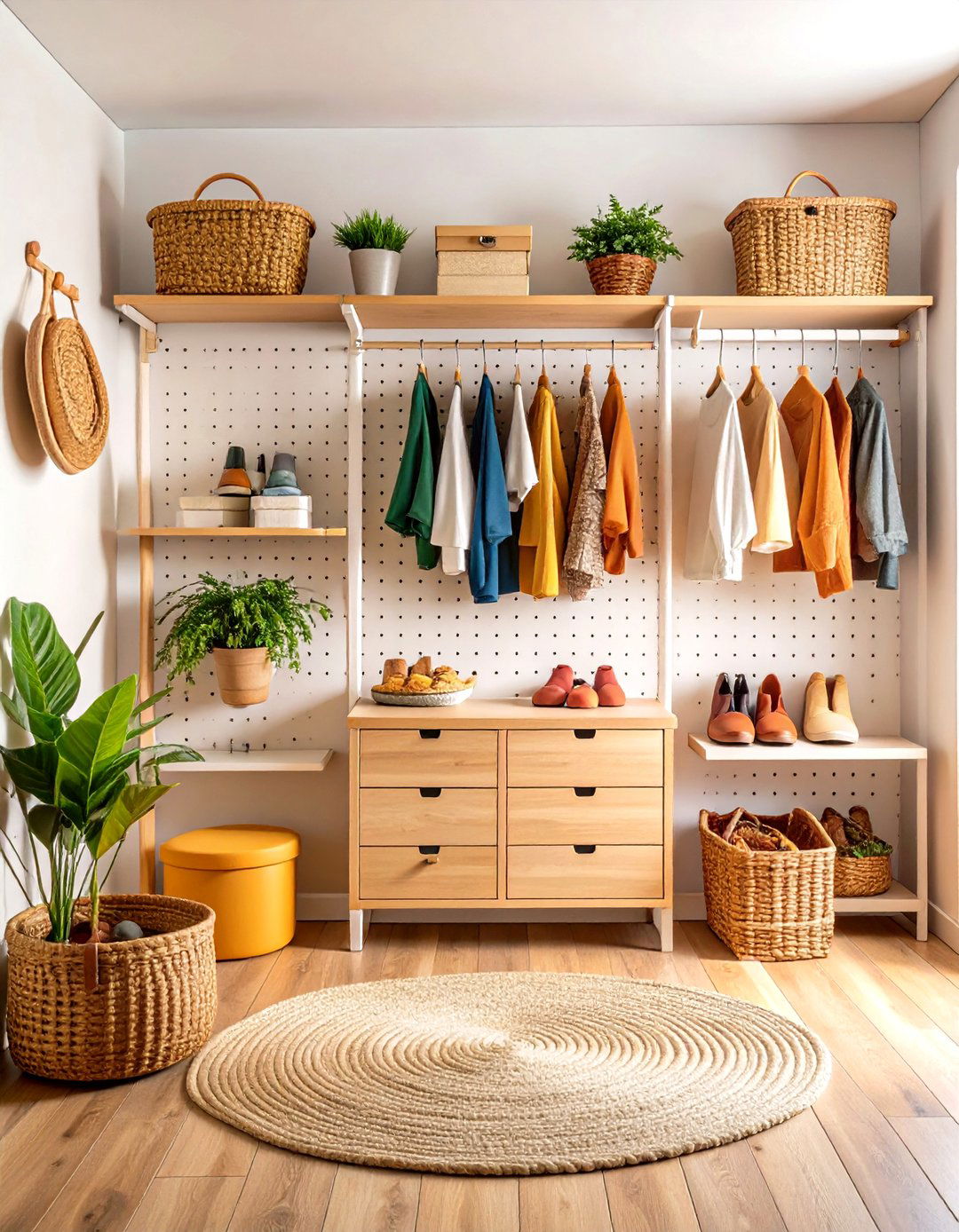
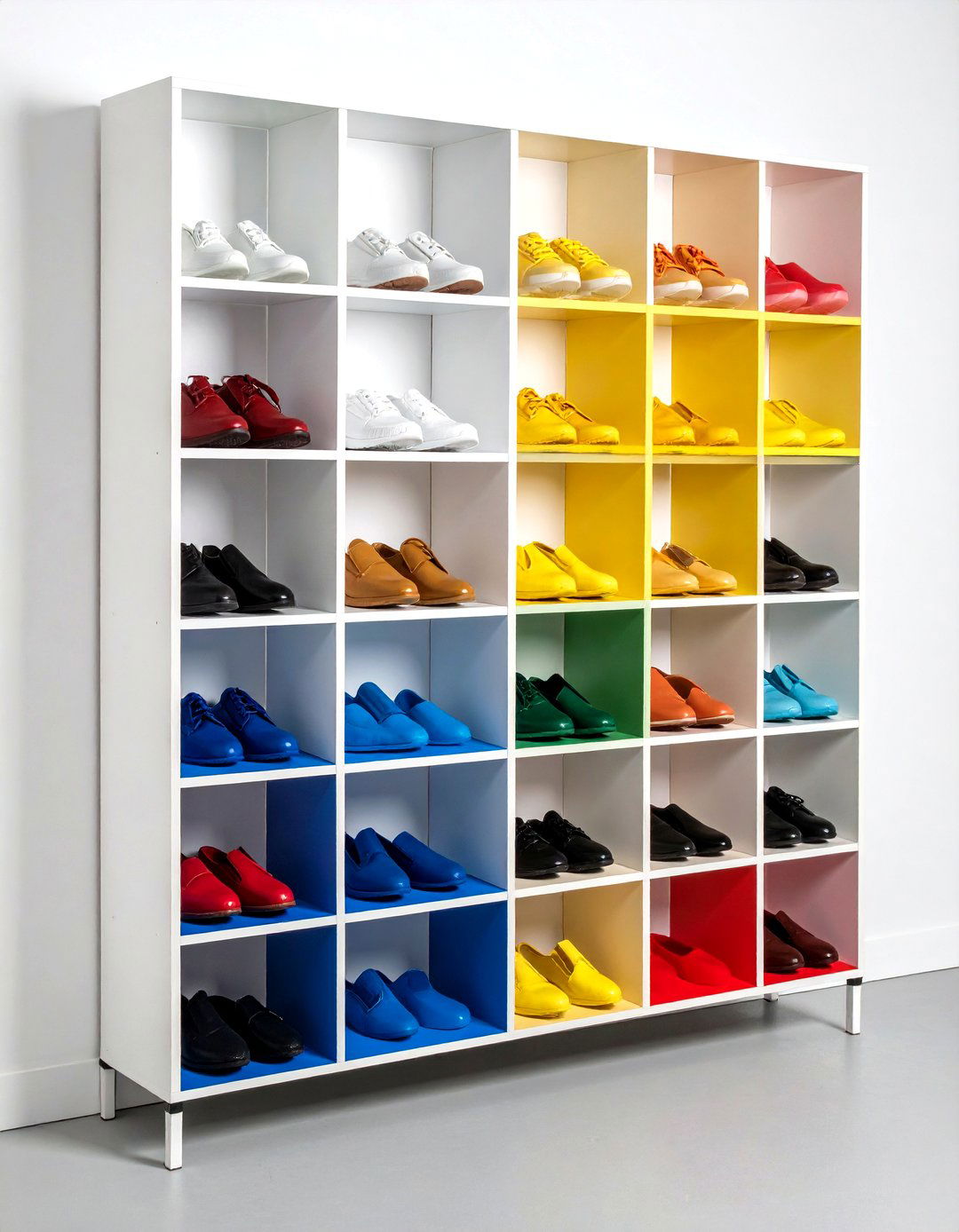
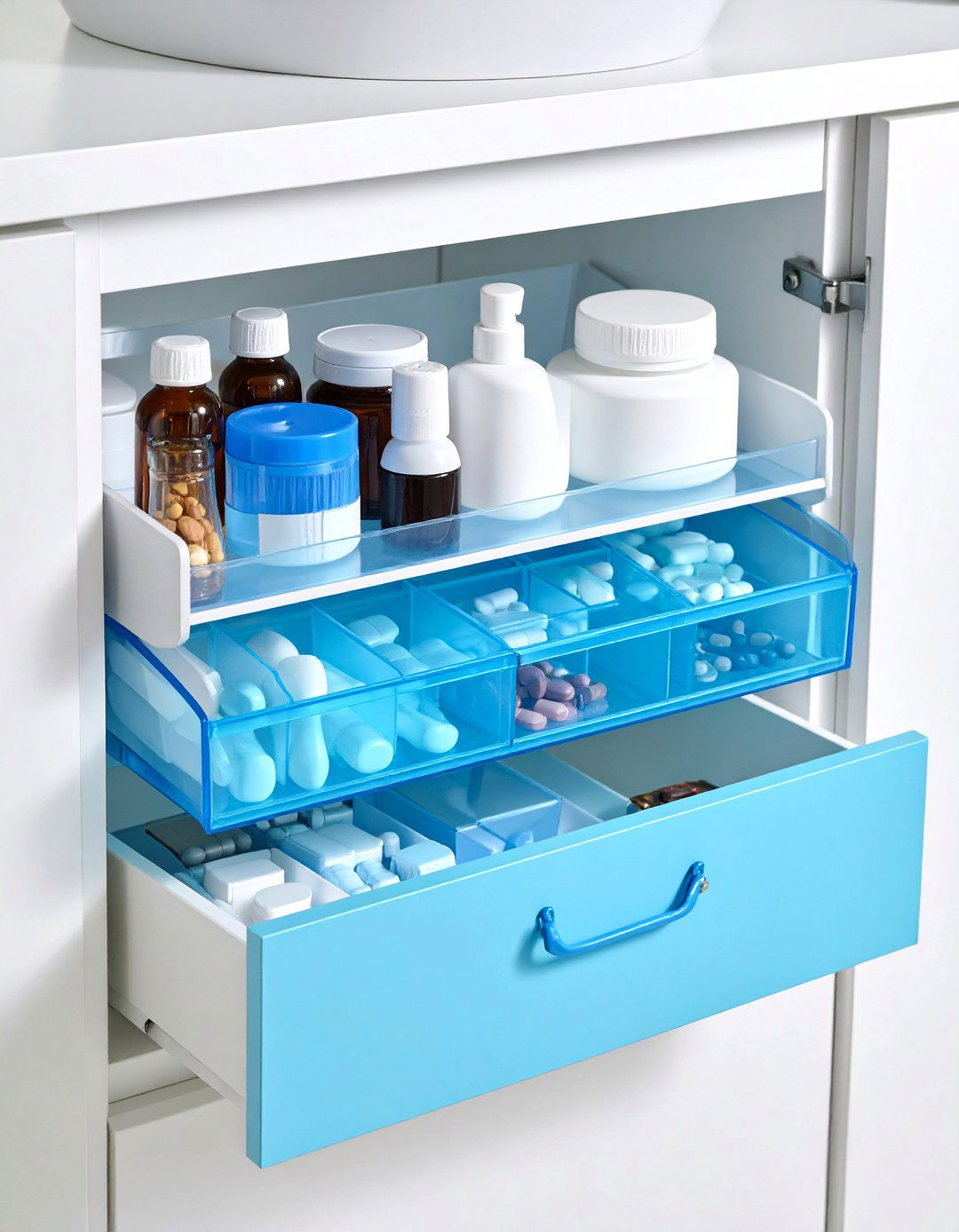


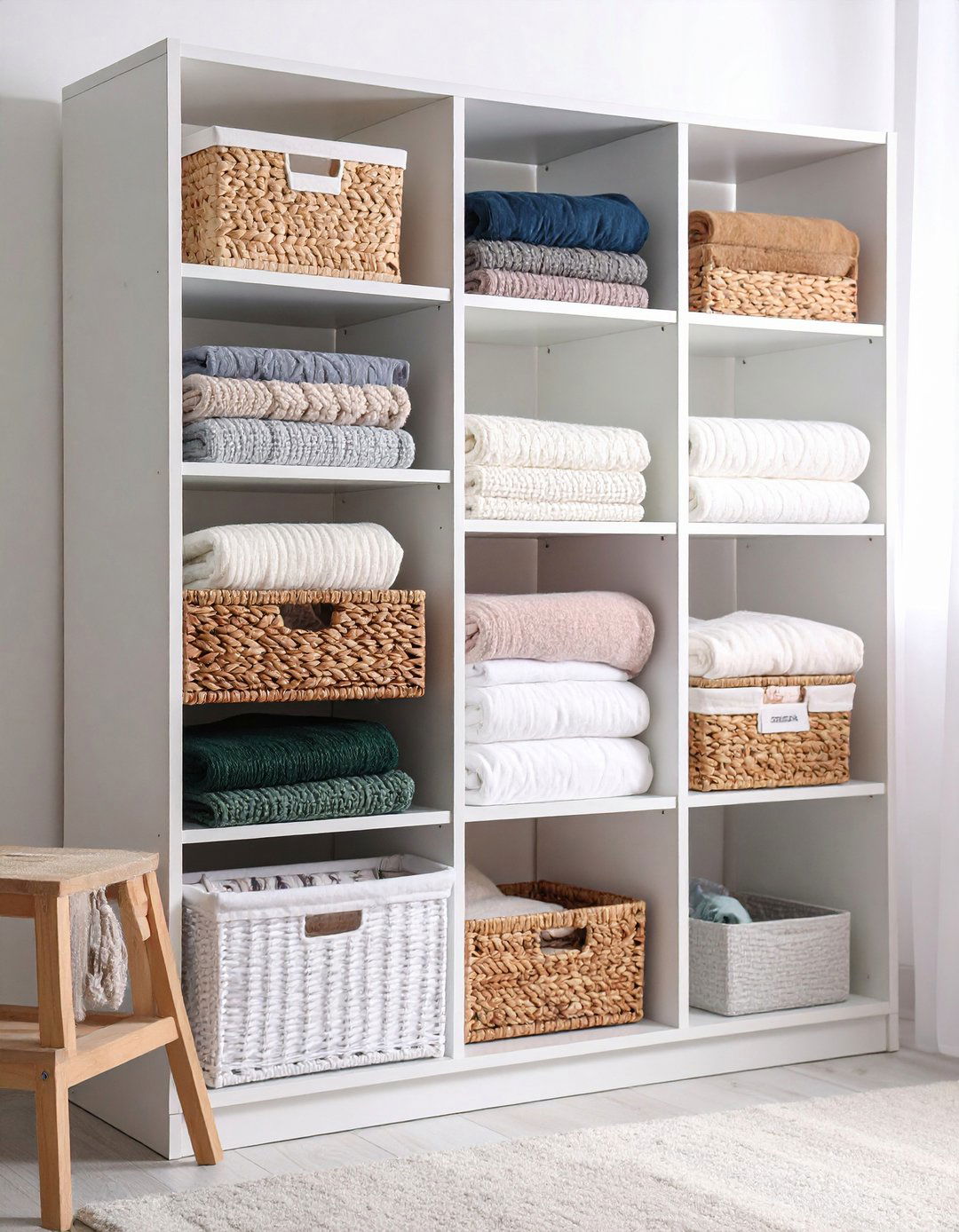
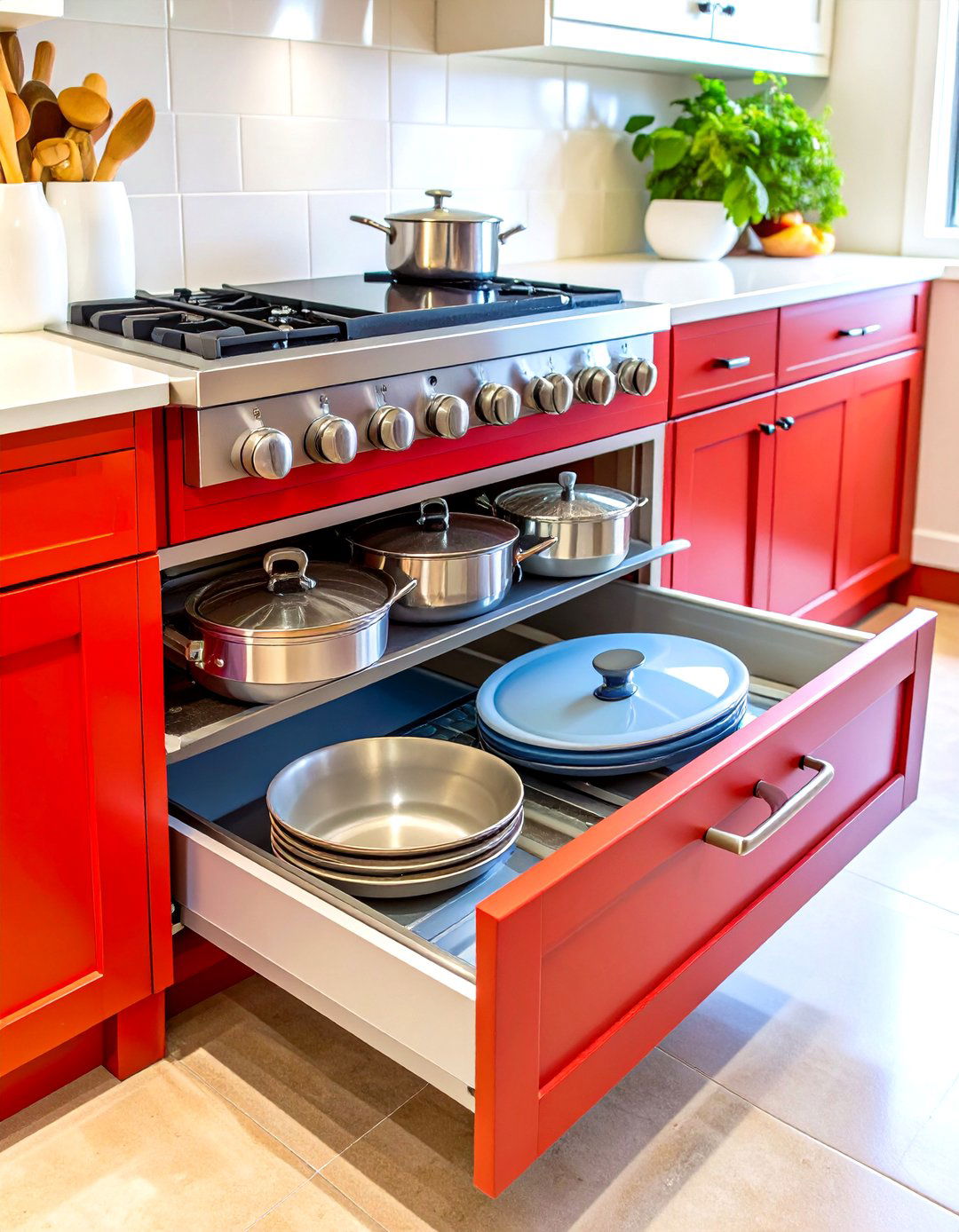
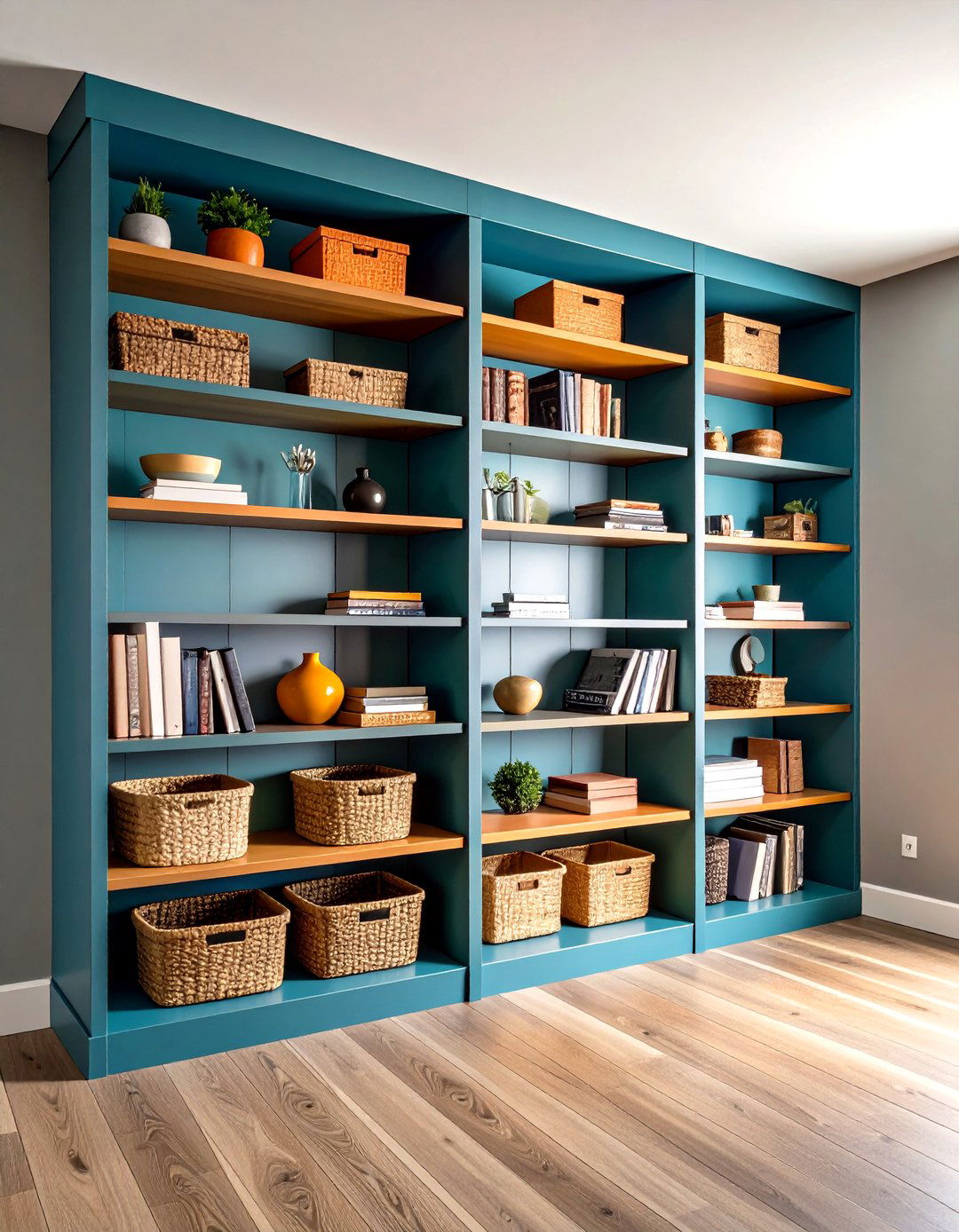
Leave a Reply